Anthony Engelsman
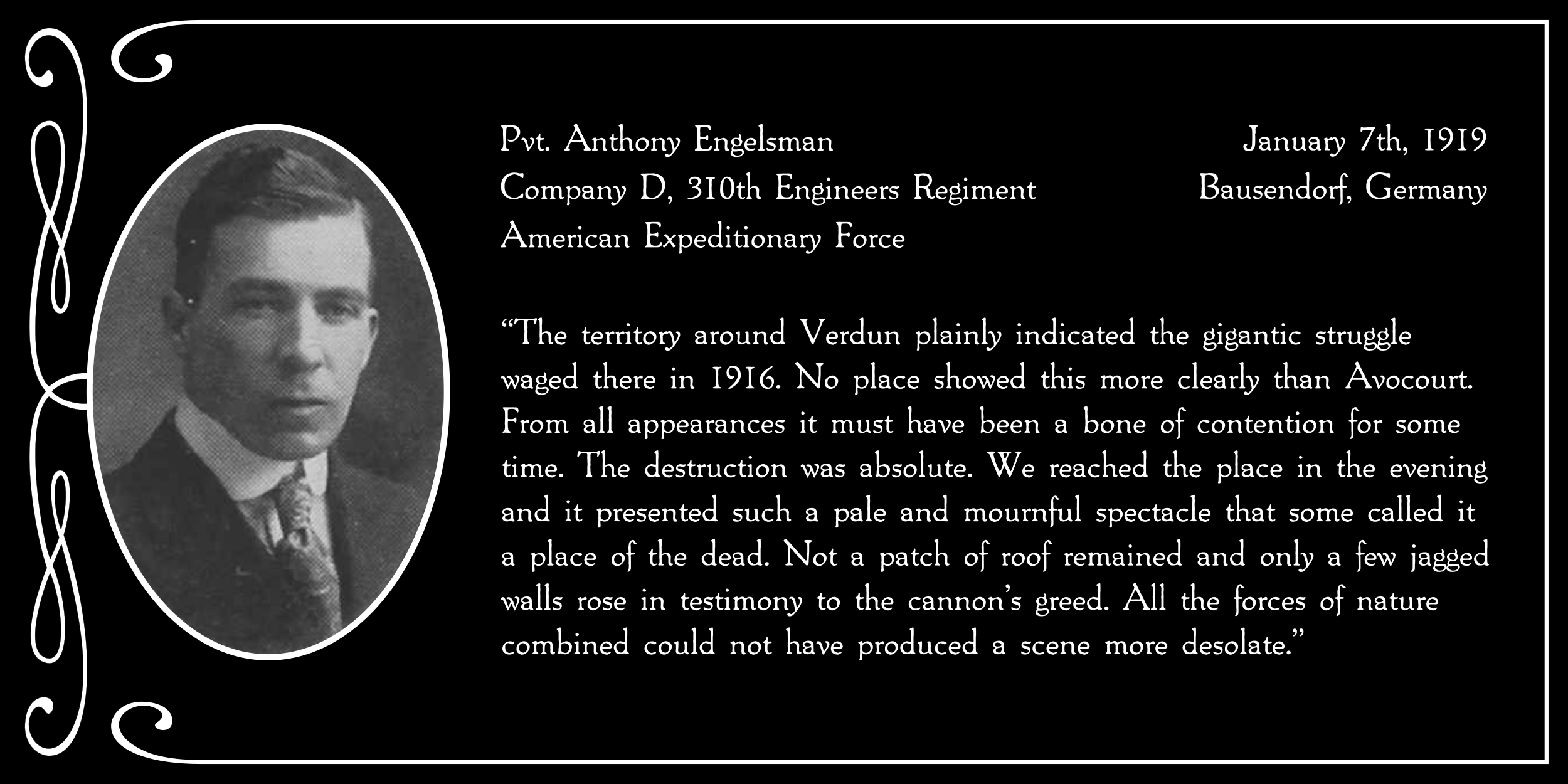
b. February 20th 1894 — d. May 9th 1984
Anthony Engelsman
Anthony Engelsman was born on February 20th, 1894 in the Overisel Township of Allegan County, Michigan. Son of Teunis and Wilhelmina (Meijer) Engelsman, Anthony was the ninth of eleven children in his family.
Teunis and Wilhelmina (Meijer) Engelsman
Anthony’s father Teunis was born on November 5th, 1842 in Doornspijk, Netherlands. A farm hand in the Netherlands, it is unclear when he emigrated to the United States.
His mother, Wilhelmina, was born on August 18th, 1857 in Overisel, Michigan, six years after her parents emigrated to the United States from Nieuwleusen, Netherlands.
The United States and World War I
On the 28th of June 1914, Gavrilo Princip assassinated the Austrian-Hungarian heir Archduke Franz Ferdinand, leading to the start of World War I.
Almost a year later, the sinking of the British RMS Lusitania by German forces on May 7th, 1915 would lead to increased pressure for the United States to join the Allied war effort.
Anthony Engelsman was twenty years old.
 Lansing State Journal, May 8th, 1915
Lansing State Journal, May 8th, 1915
Hope College
In September 1915, four months after the sinking of the RMS Lusitania, Anthony enrolled for his second year as a preparatory student at Hope College in Holland, Michigan.
He was listed in the “A” Class of the Preparatory School Roll, having won 2nd prize in the Preparatory School Oratorical Prize the previous year. Anthony was also listed as a member of the Meliphone Society at the college.
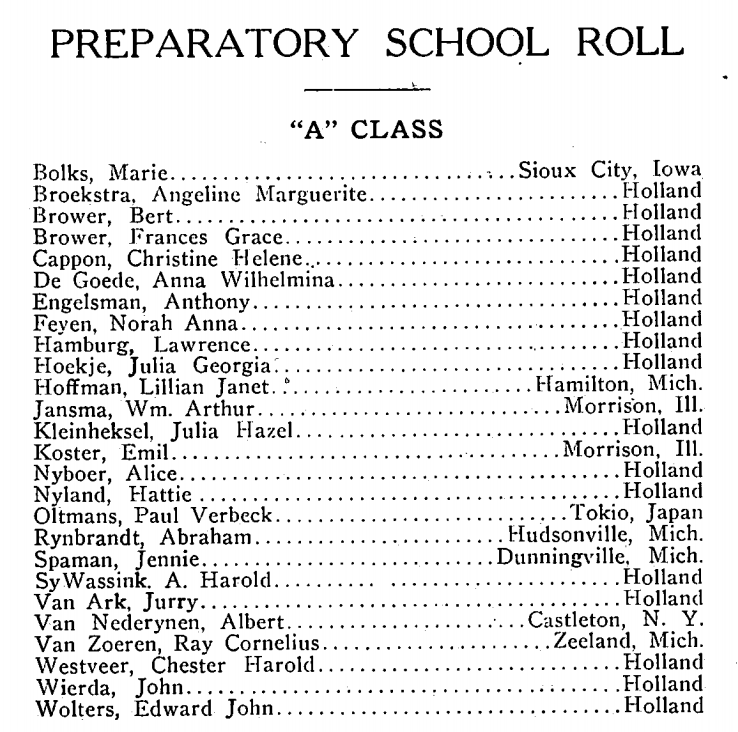 Hope College May Bulletin, 1916
Hope College May Bulletin, 1916
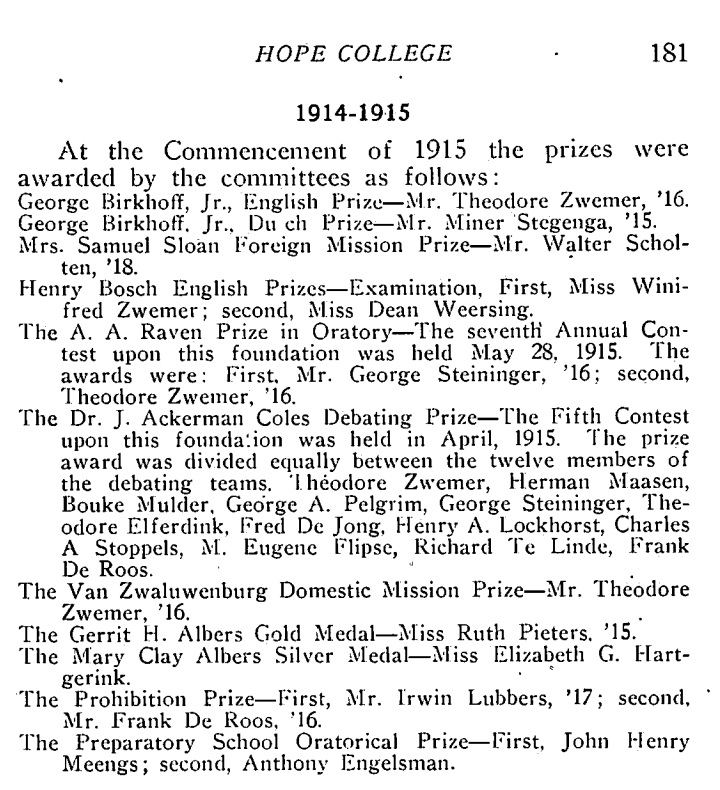 Hope College May Bulletin, 1916
Hope College May Bulletin, 1916
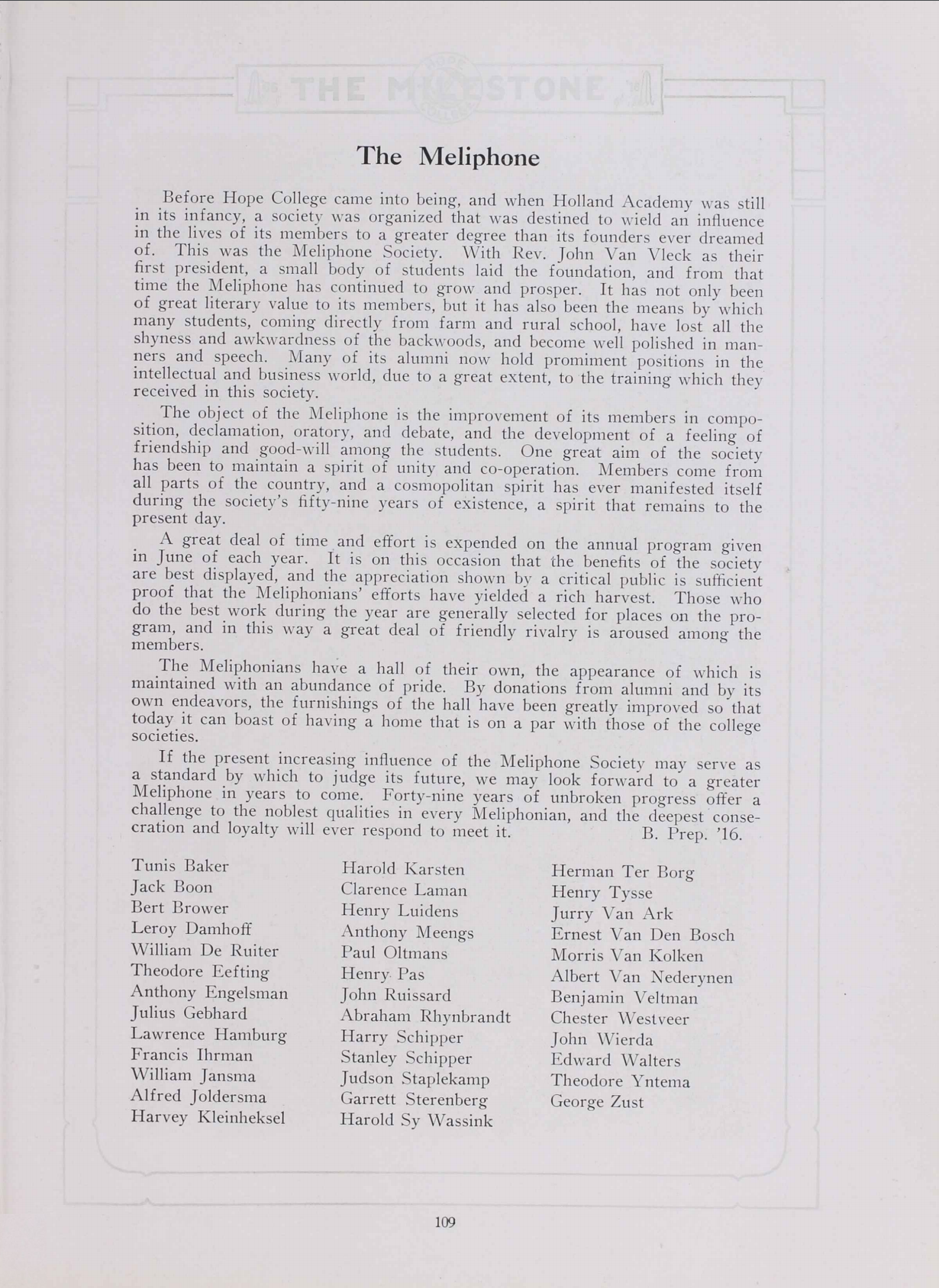 Hope College Milestone, 1916
Hope College Milestone, 1916
Freshman Year
After finishing preparatory school, Anthony would go on to enroll at Hope College in 1916 as a freshman in the Class of 1920.
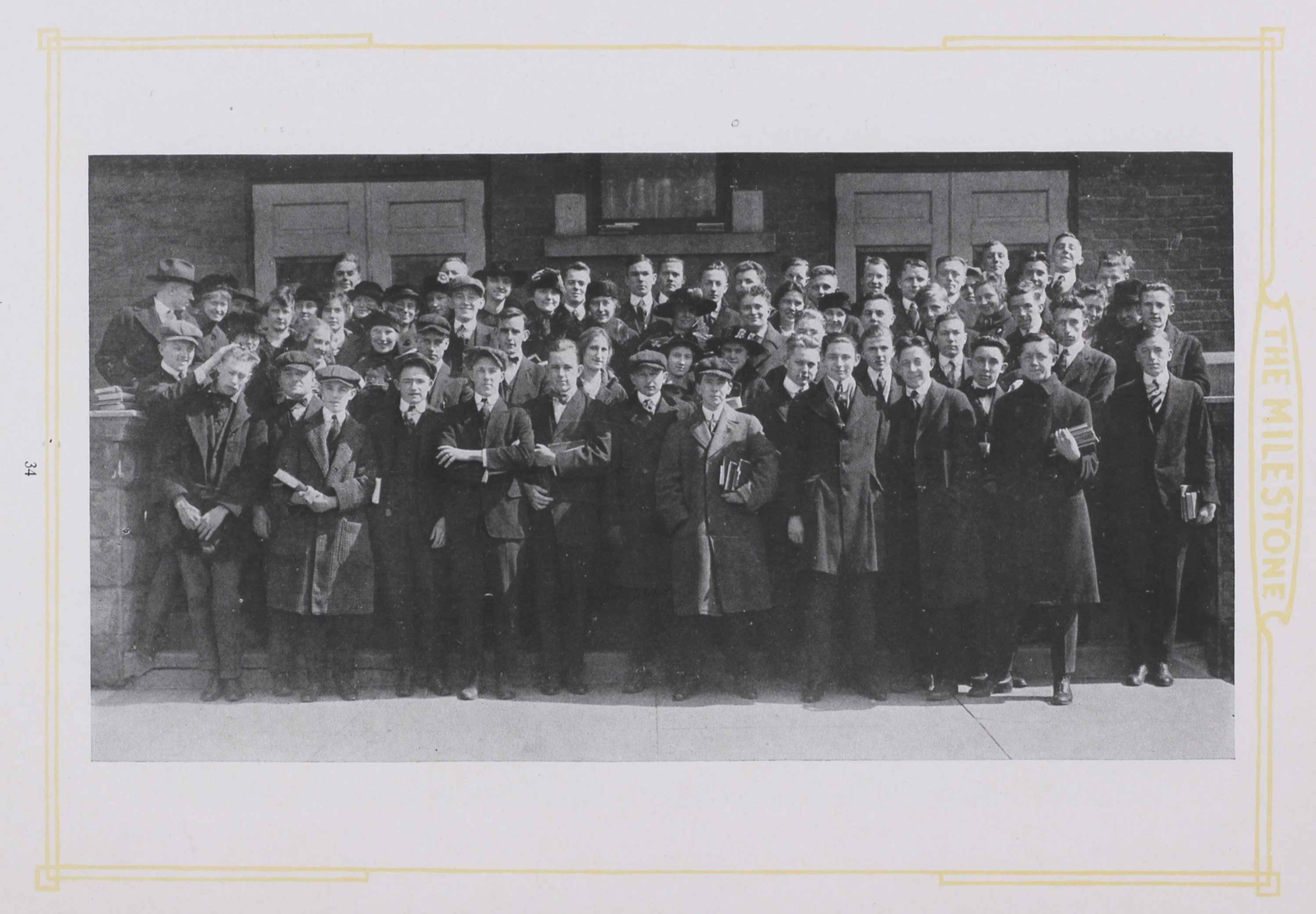 Hope College Milestone, 1917
Hope College Milestone, 1917
 Hope College Milestone, 1917
Hope College Milestone, 1917
The U.S. Enters World War I
Before the end of Anthony’s freshman year at Hope College, President Woodrow Wilson officially signed a congressional declaration of war against Germany on April 6th, 1917. The United States had officially entered World War I.
Selective Service
Shortly after declaring war, President Wilson signed into law the Selective Service Act of 1917 on May 18th. The act authorized the U.S. military to raise a national army through conscription to fight in World War I.
Anthony Engelsman, at the age of 23, registered for the draft authorized by the act a few weeks later on June 5th, 1917.
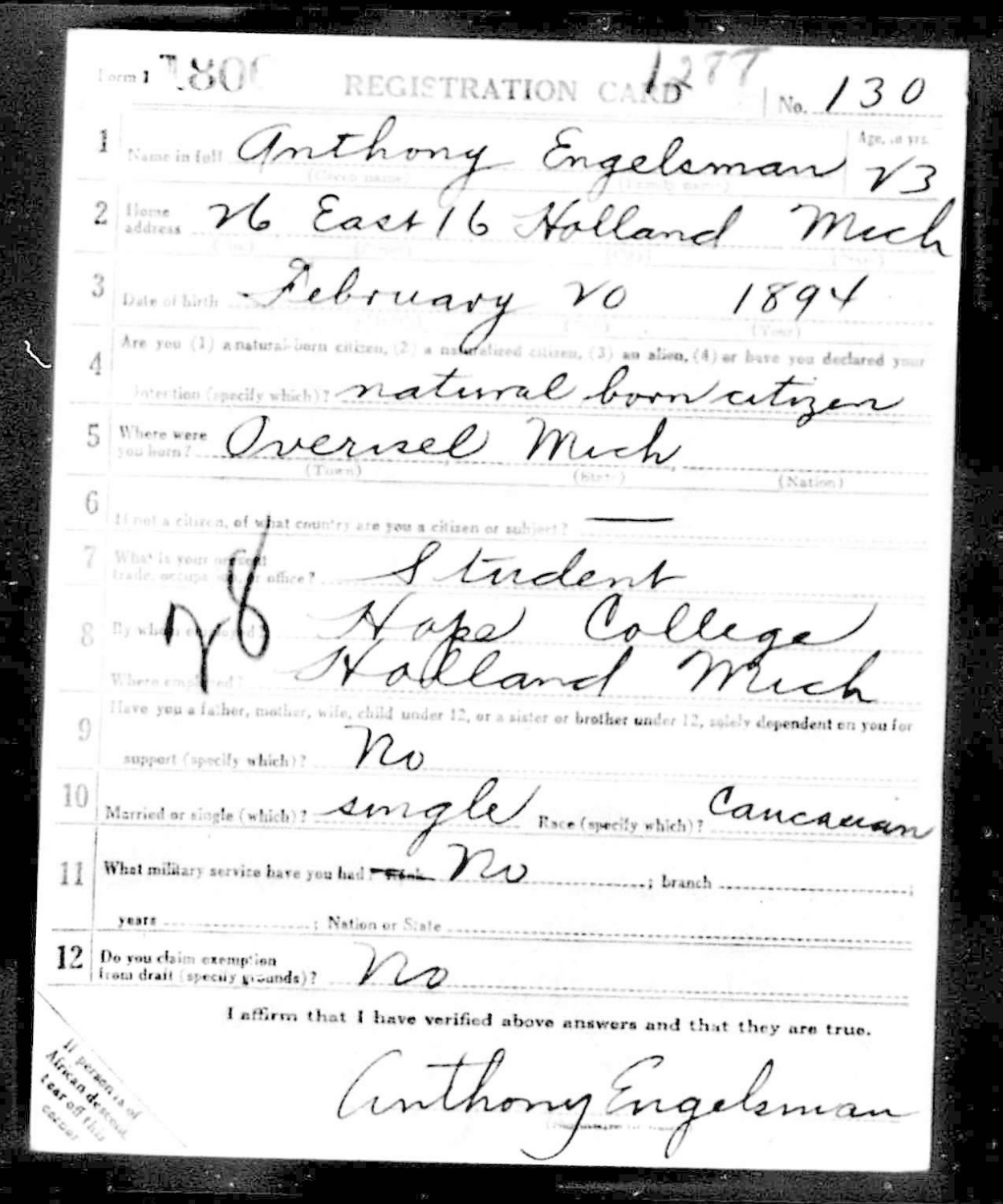 U.S. Selective Service Registration Card, 1917
U.S. Selective Service Registration Card, 1917
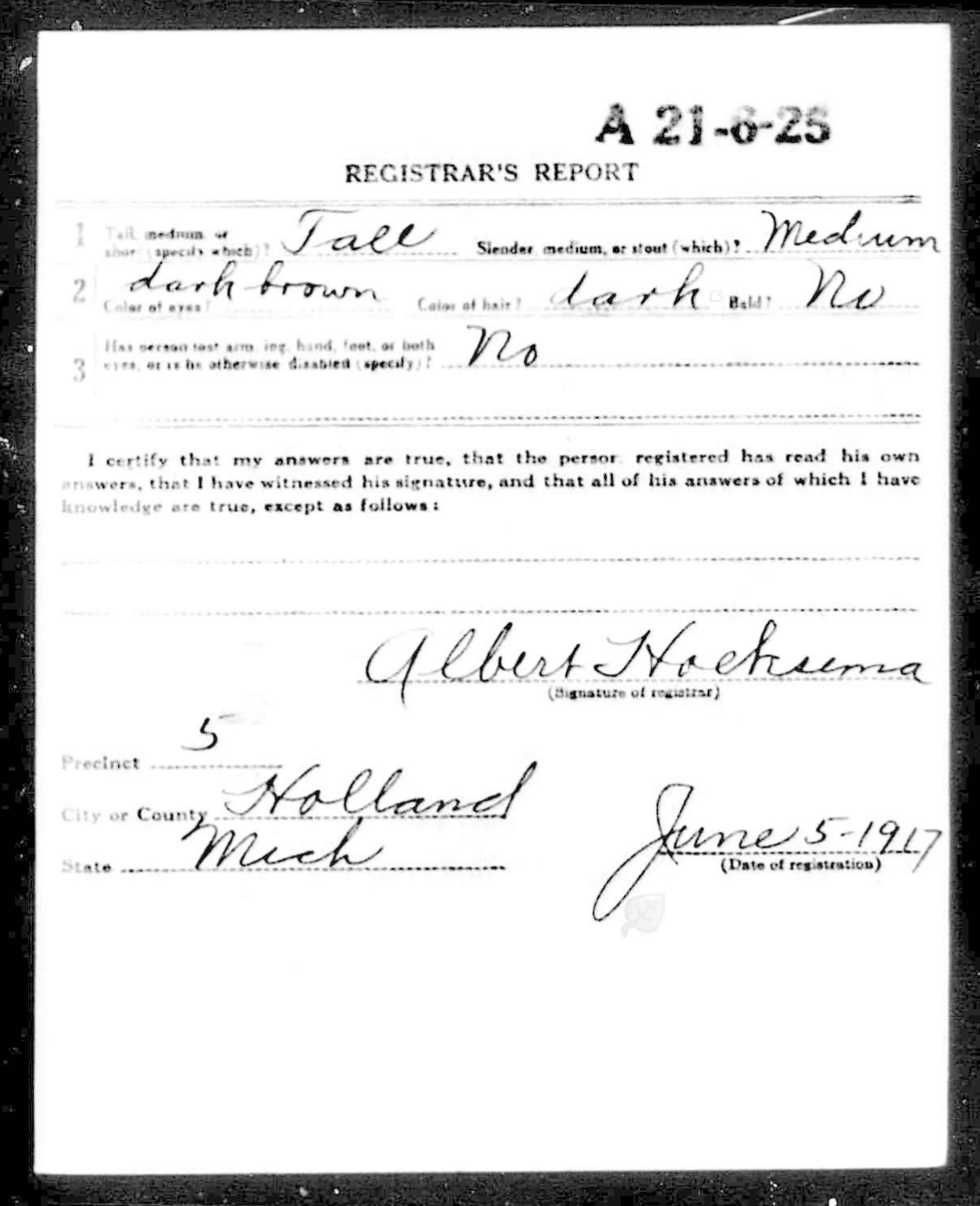 U.S. Selective Service Registration Card, 1917
U.S. Selective Service Registration Card, 1917
Sophomore Year
In the fall of 1917, Anthony should have started his second year at Hope College. However, his name is not mentioned in the sophomore class listed in the 1918 yearbook.
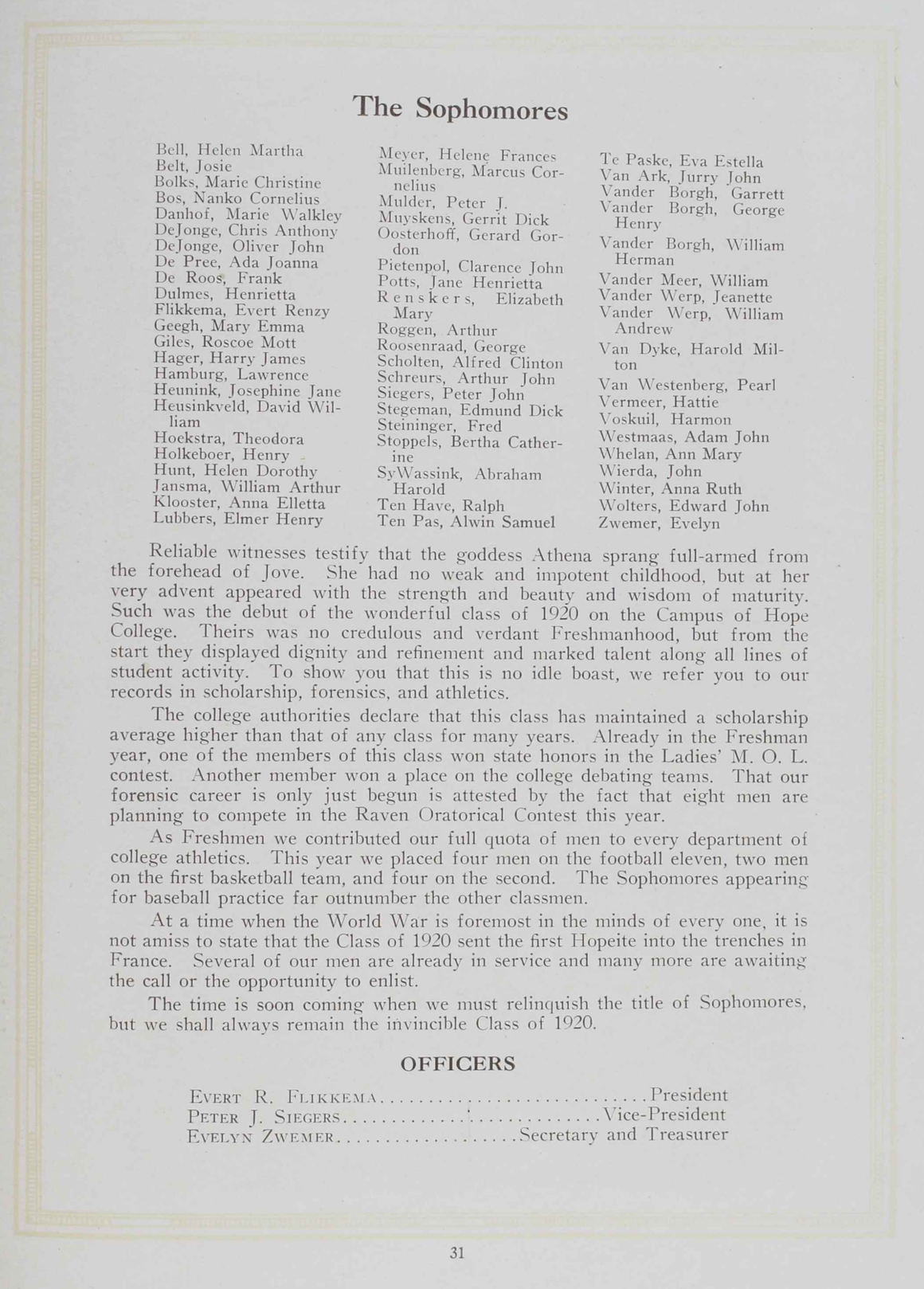 Hope College Milestone, 1918
Hope College Milestone, 1918
Hope Students Go To War
The yearbook page for the sophomore class includes the following comment:
“At a time when the World War is foremost in the minds of every one, it is not amiss to state that the Class of 1920 sent the first Hopeite into the trenches in France. Several of our men are already in service and many more are awaiting the call of the opportunity to enlist.”
A Return To Hope College
For reasons unknown, Anthony Engelsman did not return to Hope College to start his sophomore year in the fall of 1917. But he eventually returned to Hope College in the second term of that school year, sometime in late January 1918.
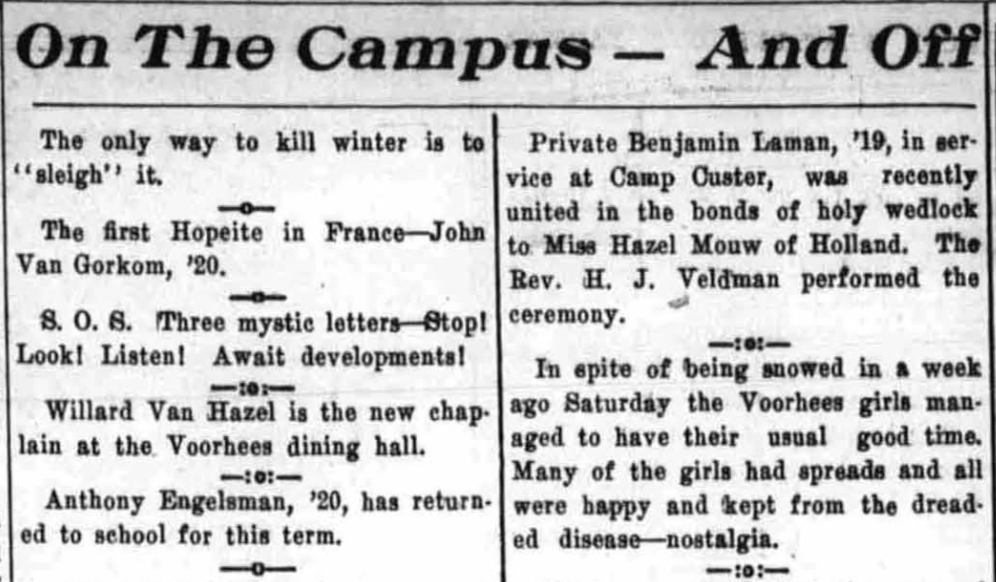 Hope College The Anchor, January 23rd 1918
Hope College The Anchor, January 23rd 1918
Around The World In Eighty Days
A few months after returning to Hope College, Anthony Engelsman published a story in a March 1918 issue of the Hope College student newspaper, The Anchor. The title of the tongue-in-cheek story, as well as its premise, is a reference to the famous adventure novel of the same name published by Jules Verne in 1873.
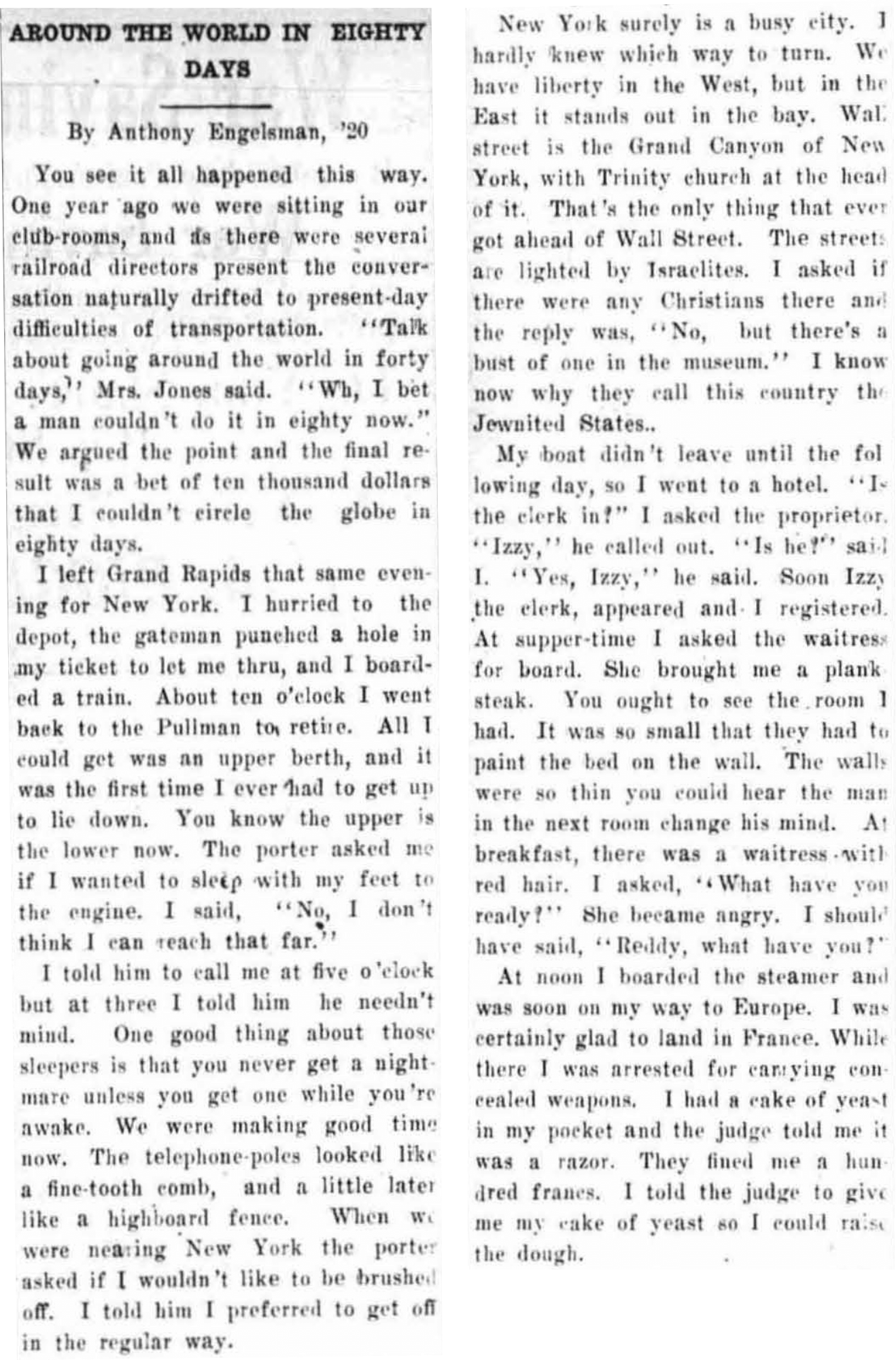 Hope College The Anchor, March 6th 1918
Hope College The Anchor, March 6th 1918
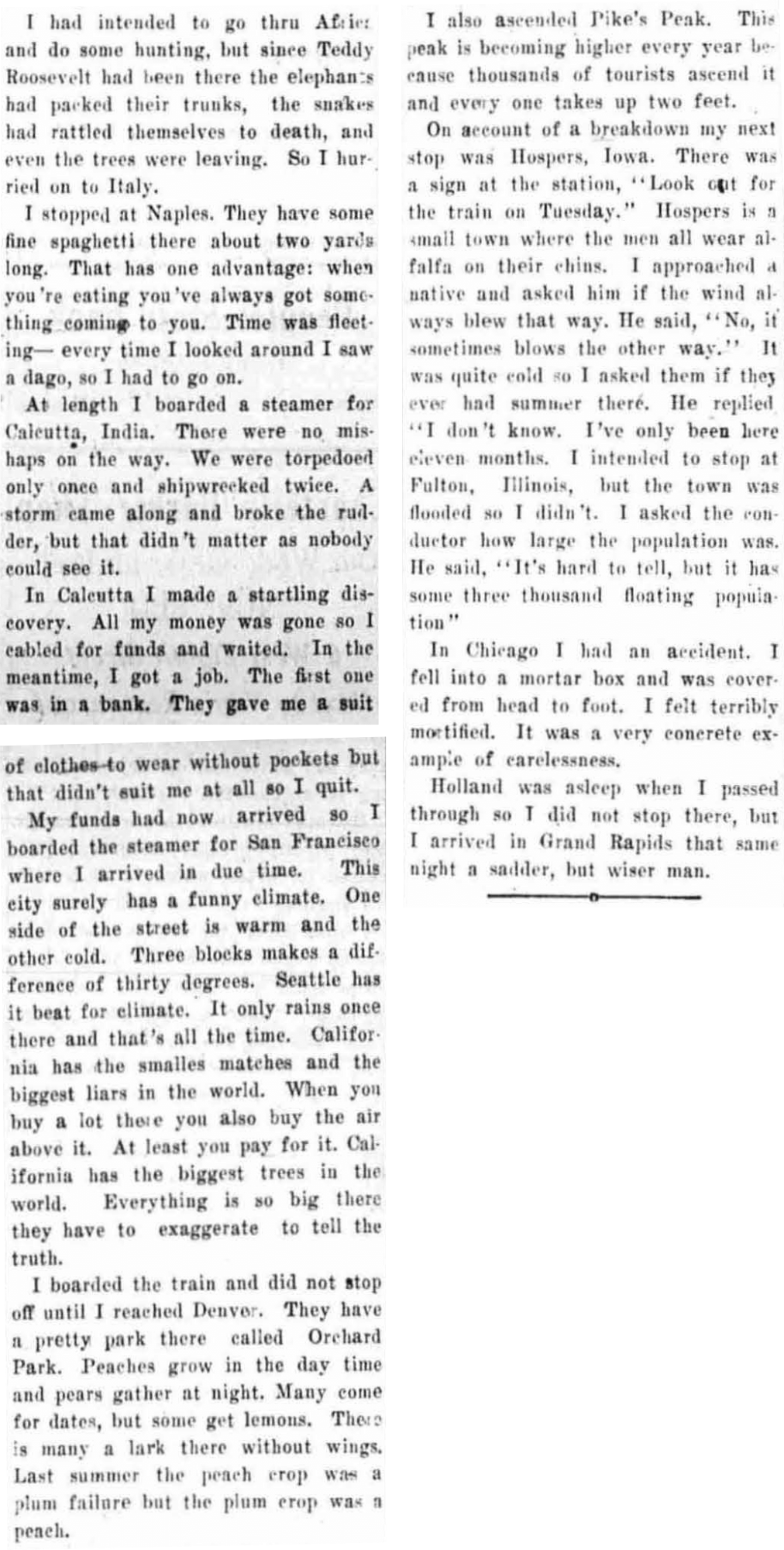 Hope College The Anchor, March 6th 1918
Hope College The Anchor, March 6th 1918
Off To War
About a month after his story was published, the student newspaper published notice that Anthony Engelsman would be leaving college to join the war effort in late April of 1918.
With an enlistment date of April 29th, Anthony Engelsman left Hope College for Camp Custer in Battle Creek, Michigan to begin his training in the United States Army.
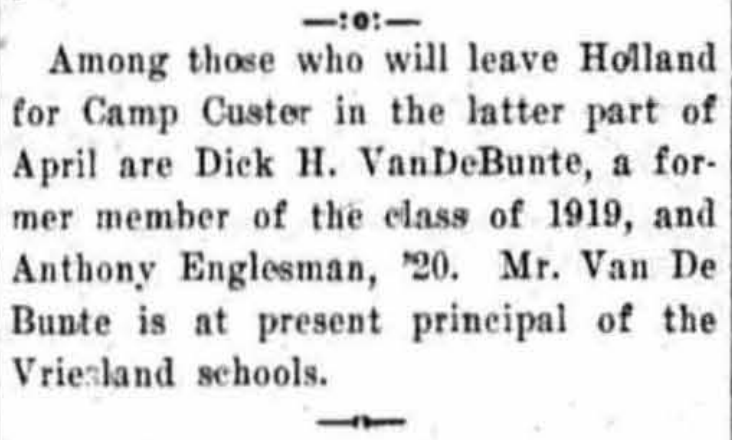 Hope College The Anchor, April 17th 1918
Hope College The Anchor, April 17th 1918
Camp Custer
Camp Custer was a regional training camp for the United States military, located about 5 miles west of Battle Creek, Michigan. Built in July 1917 and officially opened in October 1917, it provided staged training for the 85th Infantry Division.
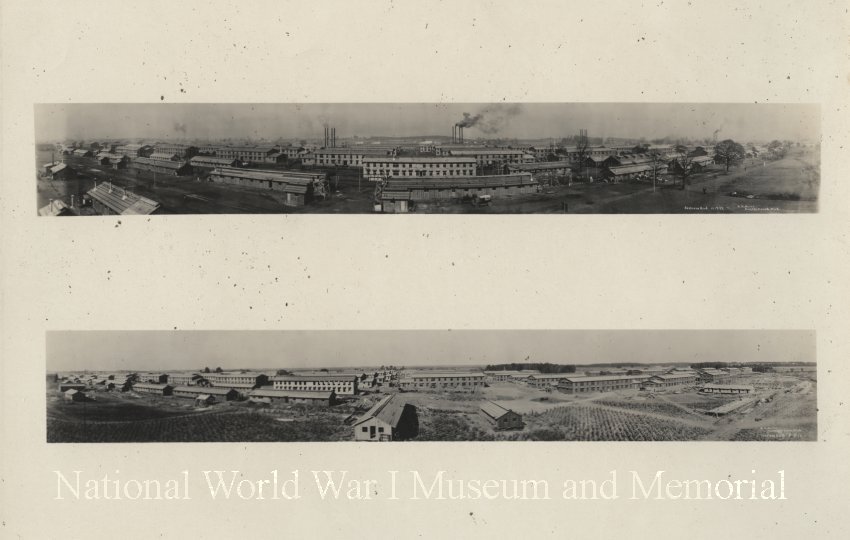 National Army Cantonments, Plans and Photography, June 1918
National Army Cantonments, Plans and Photography, June 1918
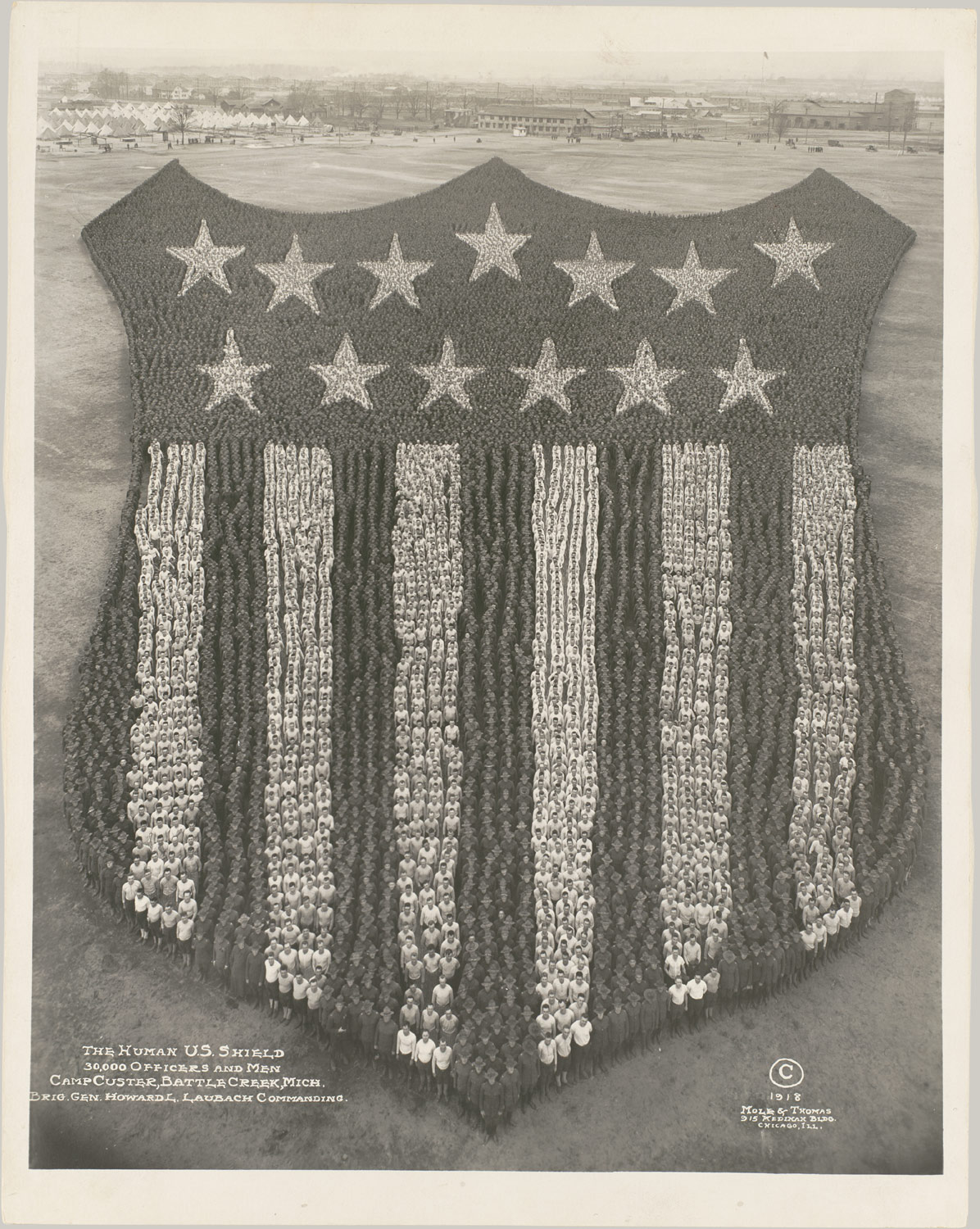 The Human U.S. Shield (at Camp Custer), Mole & Thomas, 1918
The Human U.S. Shield (at Camp Custer), Mole & Thomas, 1918
The 85th Infantry Division
The 85th Infantry Division, known as Custer Division, was made up of infantry and artillery regiments, as well as medical, engineering and reconnaissance support battalions and a depot brigade. It would serve as a replacement and depot division in the war effort overseas, providing replacement troops to other divisions in combat. Based at Camp Custer, the 85th Infantry Division consisted of draftees from the states of Michigan and Wisconsin.
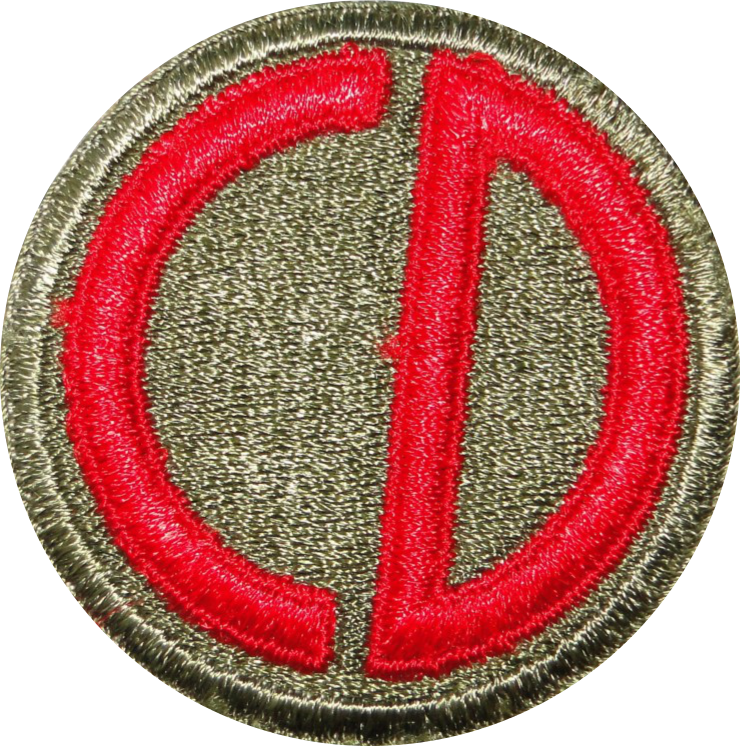
The 160th Depot Brigade
By October 1918, Anthony Engelsman was a private in the United States Army, assigned to the 160th Depot Bridge, Company 2, at Camp Custer.
 Hope College The Anchor, October 9th 1918
Hope College The Anchor, October 9th 1918
The 160th Depot Brigade was a training and receiving unit at Camp Custer, preparing soldiers for deployment and combat in the war.
The 85th Goes To War
Between March and July of 1918, the Allied armies of Britain and France were repelling the German Spring Offensive along the Western Front.
In mid-July of 1918, the 85th Infantry Division left Camp Custer for New York to begin their deployment overseas.
On July 21st, 1918, Pvt. Anthony Engelsman, now part of the 310th Engineers Battalion, Company D, left from the port of Hoboken, New Jersey on the steamship S.S. Grampian with over 2,300 soldiers and set sail to England.
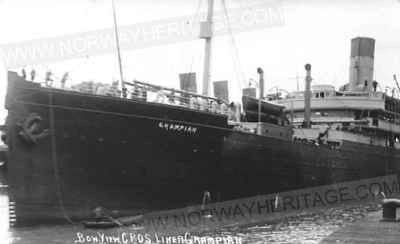 S.S. Grampian, date unknown
S.S. Grampian, date unknown
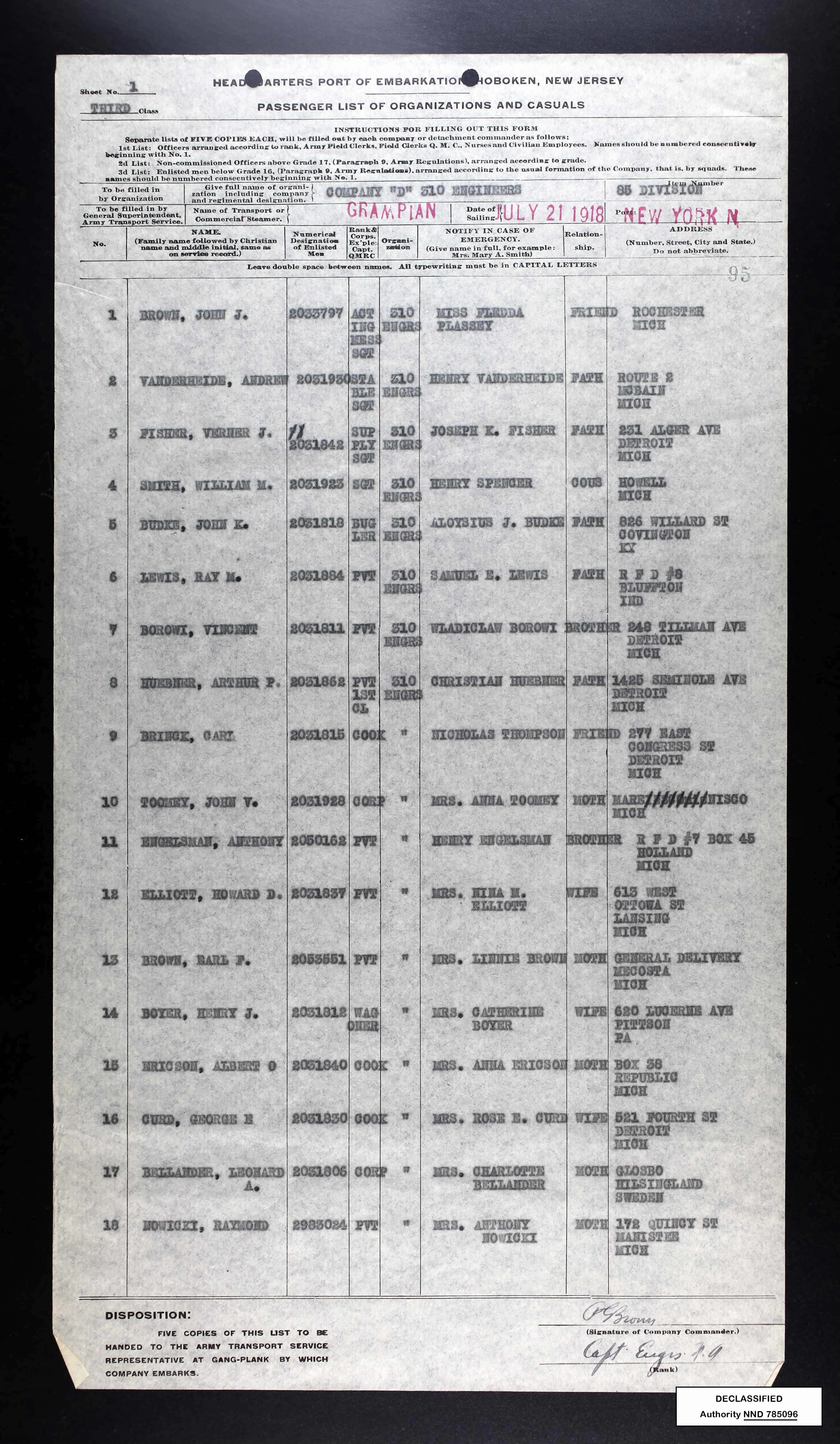 Passenger List of Organizations and Casuals, July 1918
Passenger List of Organizations and Casuals, July 1918
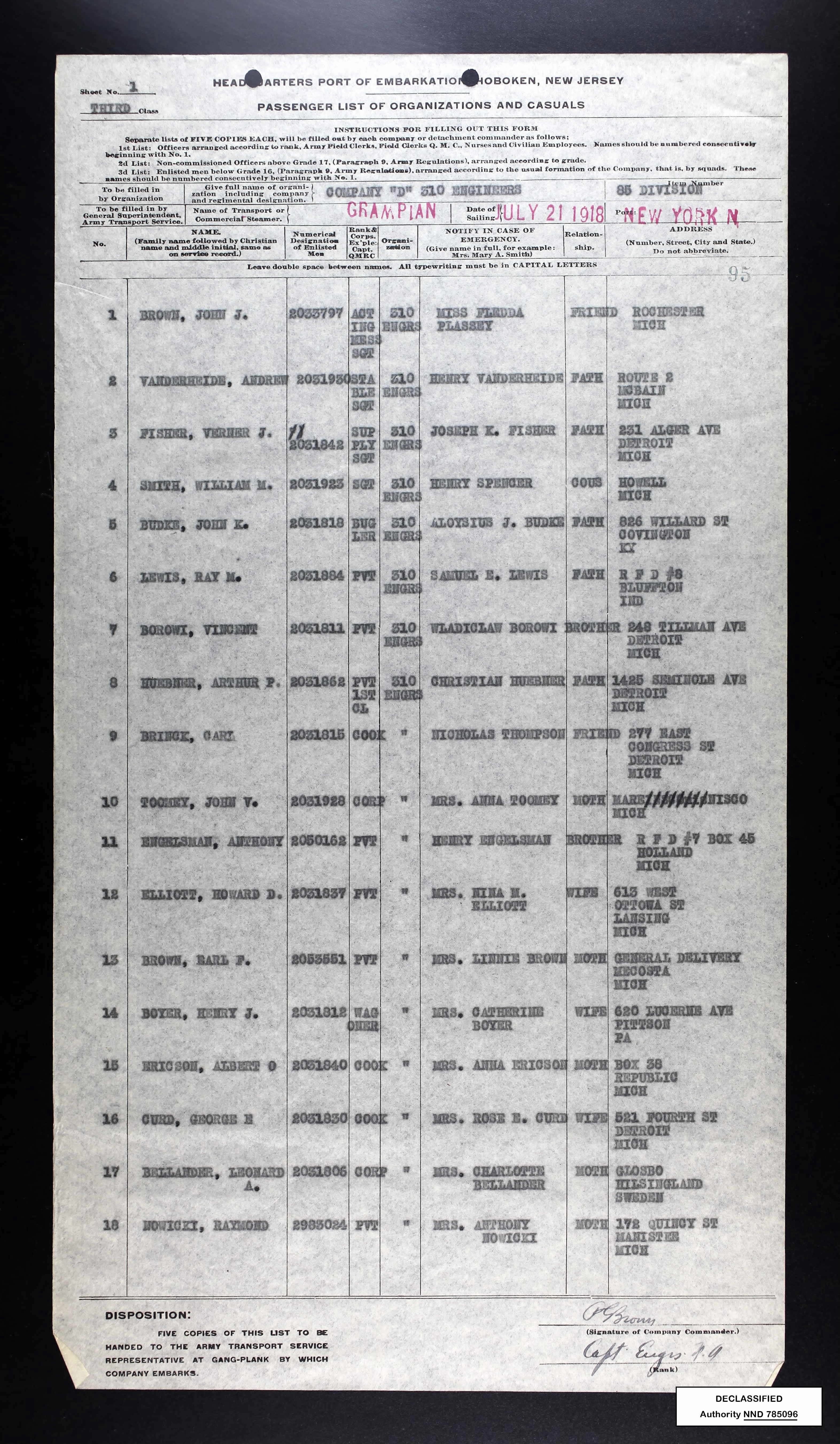 Port of Hoboken Embarkation Records, July 22nd 1918
Port of Hoboken Embarkation Records, July 22nd 1918
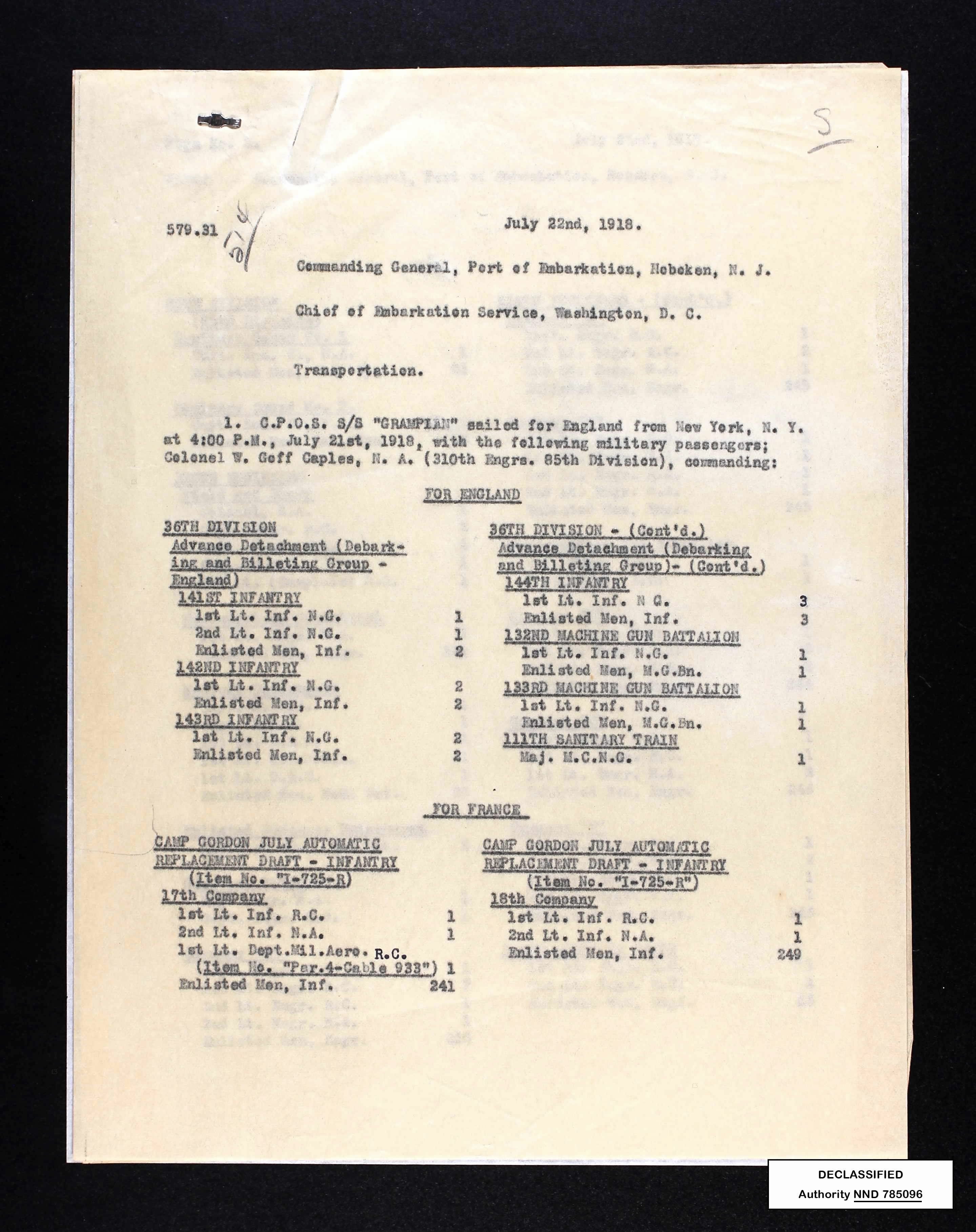 Port of Hoboken Embarkation Records, July 22nd 1918
Port of Hoboken Embarkation Records, July 22nd 1918
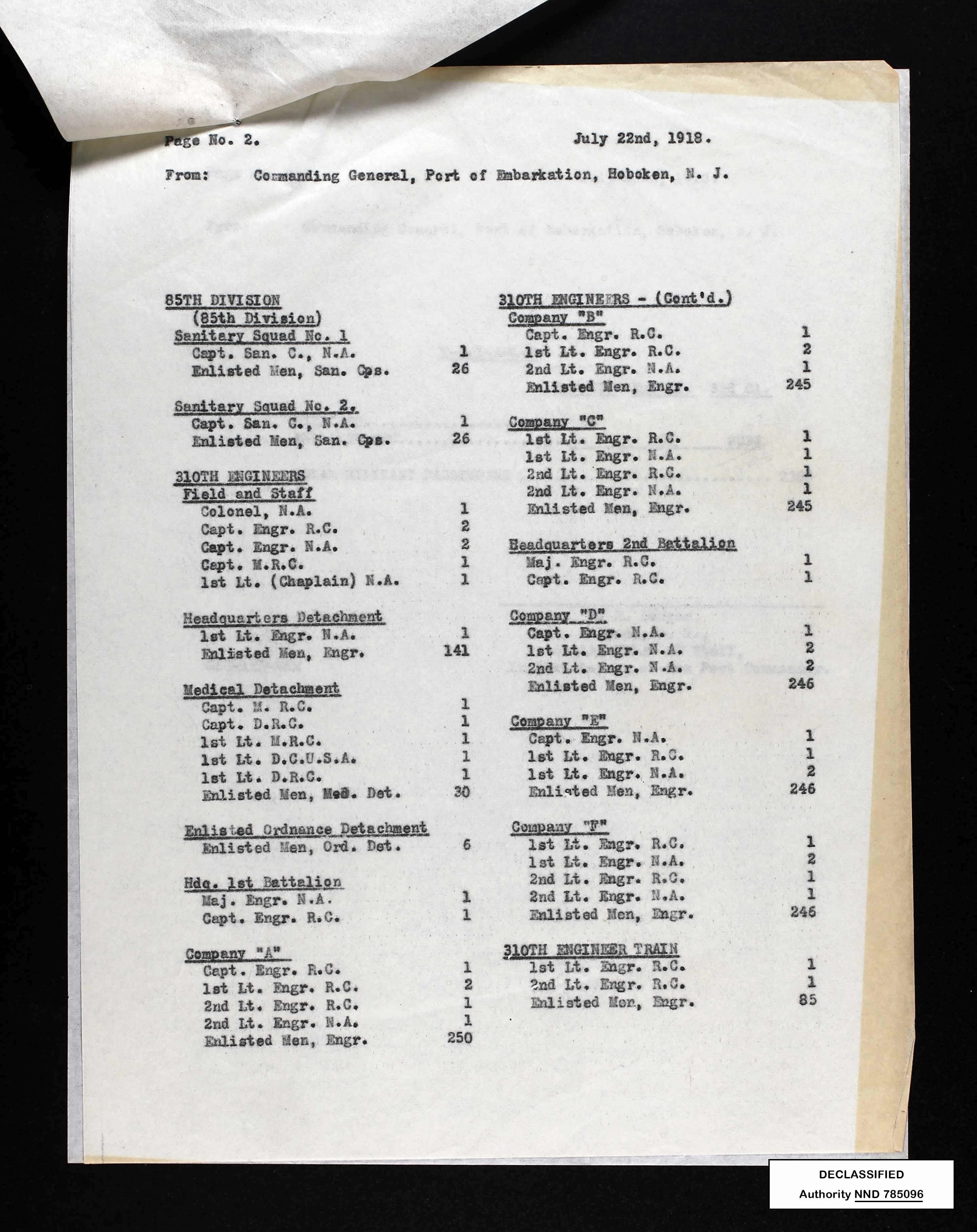 Port of Hoboken Embarkation Records, July 22nd 1918
Port of Hoboken Embarkation Records, July 22nd 1918
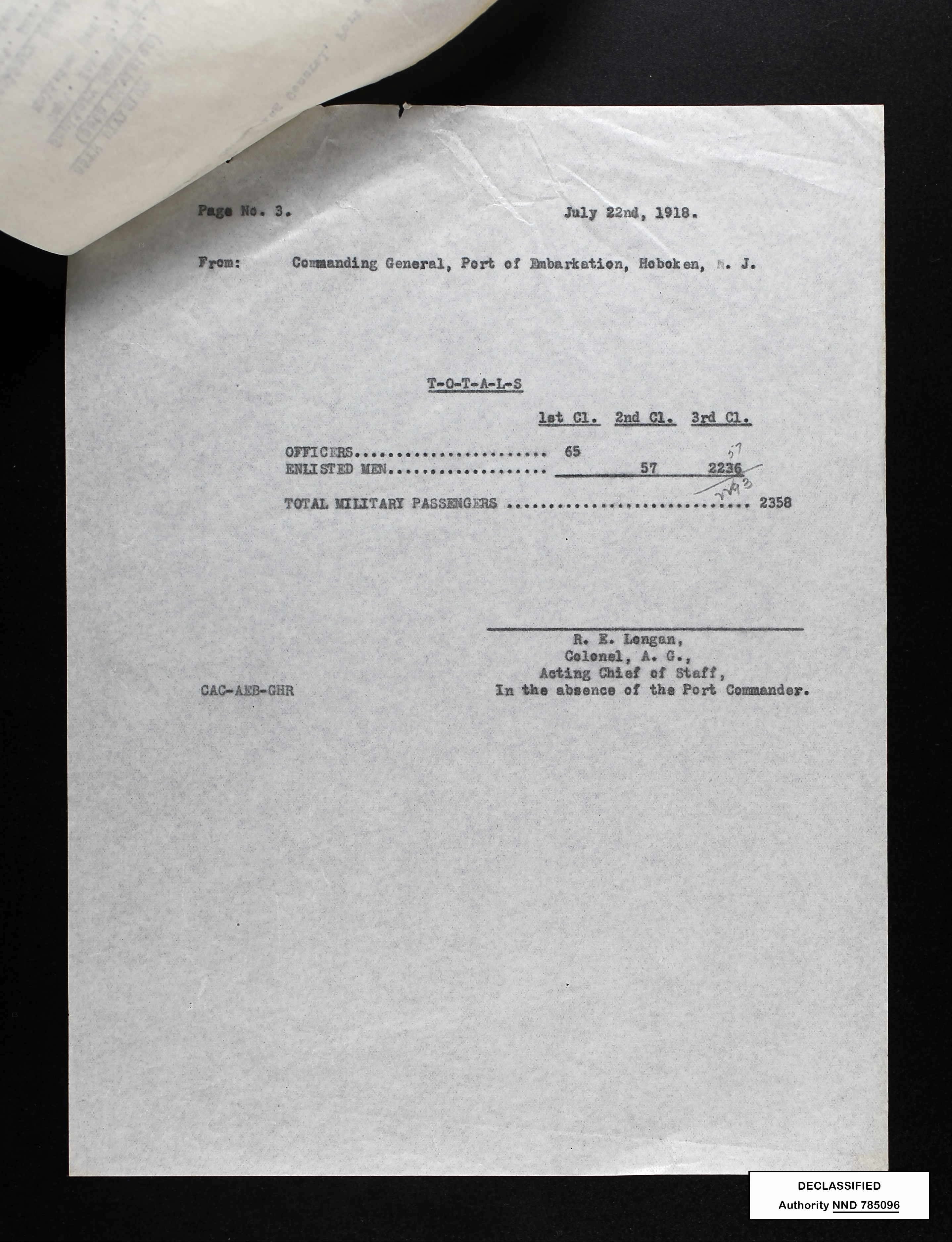 Port of Hoboken Embarkation Records, July 22nd 1918
Port of Hoboken Embarkation Records, July 22nd 1918
U.S. Casaulties In The War
A week before the departure of the 85th Infantry Division, an article in the New York Times on July 13th, 1918 provided an update on the American losses in the war. Since their involvement in the war, American forces had experienced a total of 9,970 casualties, with over 4,000 killed and over 5,000 wounded or missing.
 New York Times, July 14th 1918
New York Times, July 14th 1918
The 85th Arrives in France
Departing New York at the end of July, a two week trip by boat brought the division to Liverpool, England. And last, a short sail across the English Channel brought them to France in mid-August 18.
The 85th Infantry Division arrived in France only a week after the start of the Hundred Days Offensive, an Allied offensive push that began on August 8th, 1918 to repel Germany’s advances. Stationed in Lorraine, France, the 85th Infantry Division would go on to provide troop replenishment for other divisions in combat until the end of the war.
Armistice
The German army was ultimately repelled by the Hundred Day Offensive and pushed back to the Hindenburg Line. This effectively ended the war, and World War I was officially over with the signing of the armistice on November 11th, 1918, roughly three months after Pvt. Anthony Engelsman had arrived in France.
A Letter Home to Hope
In February of 1919, Pvt. Anthony Engelsman wrote to Hope College President Edward D. Dimnent from his deployment in France. With the war over, he had remained behind as part of the Army of Occupation in Germany.
He included some copies of German propaganda that had been dropped from an airplane on November 1st, only ten days before the armistice. Additionally, he included a long letter dated January 7th, 1919 in which he described his experiences in the war.
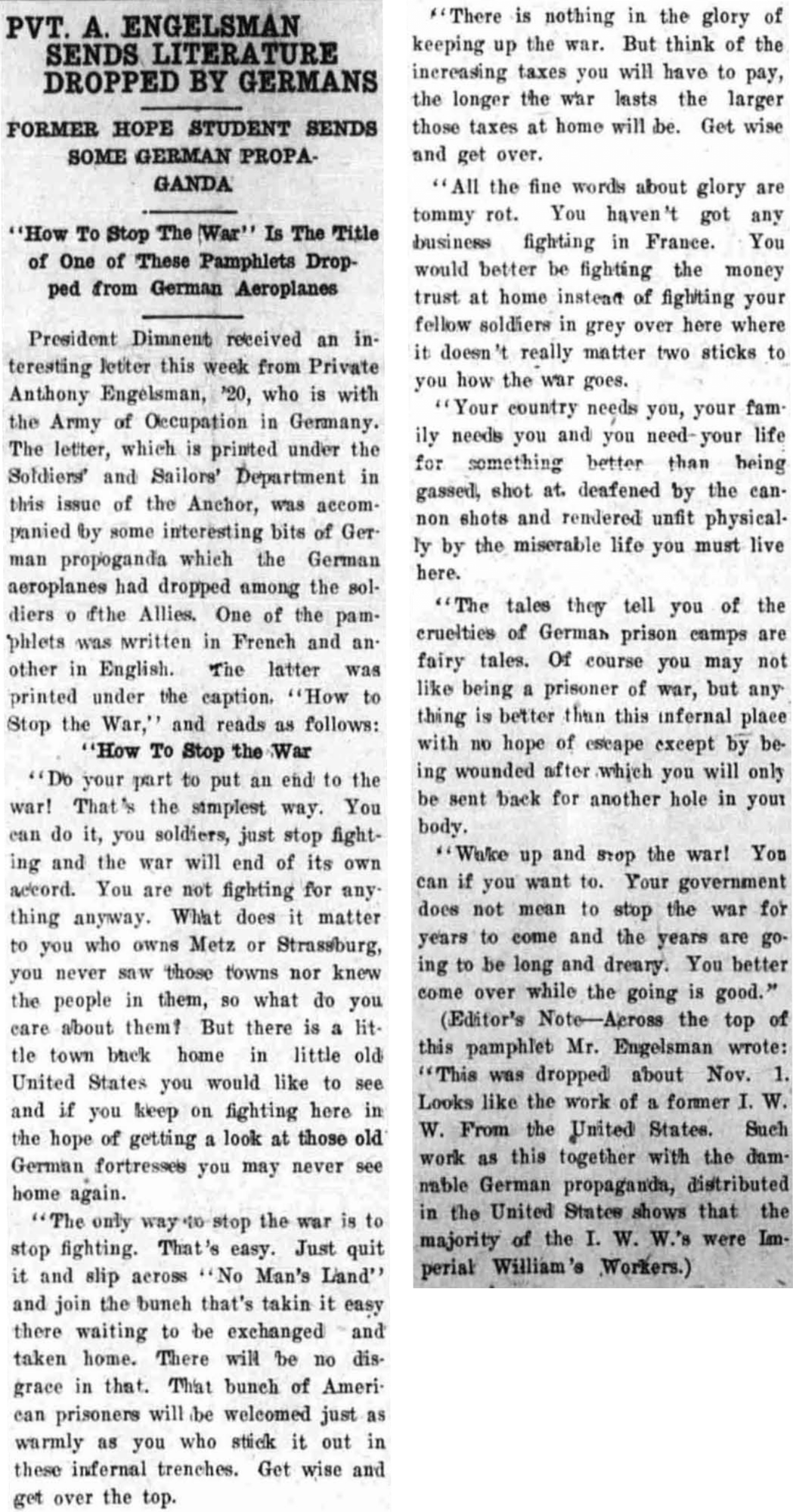
Hope College The Anchor, February 19th 1919
From Training To The Front
He also included a detailed letter dated January 7th, 1919 in which he described his experiences in the war:
- Sent abroad three months after entering the service, then on to the war front a month later.
- Landed at Liverpool, England on August 3rd, 1918 after a voyage of thirteen days.
- Entrained to Southhampton after arriving in Liverpool.
- Rested a few days then embarked for France, arriving in Havre for another days rest, then on to St. Satur, a village on the Louire near Bourges.
- Billeted at St. Satur for a month for acclimation and training.
- In early September 1918, sent to the St. Mihiel front for a brief time then on to the Argonne region until hostilities ended on November 11th, 1918.
- During troop marches, passed through the towns of Monilly, Avocourt, Montfaucon, Epinonville, Laundres, St. Georges and Busanzy.
Army Of Occupation
After the armistice in November 1918, he notes the following:
- While in Stenay, France, they received news that they would be part of the Army of Occupation in Germany.
- A few days later, they began traveling through Northern France, a corner of Belgium, through Luxemburg and along the Moselle into Germany, likely arriving in Bausendorf, Germany where the letter was written.
The Battle Of Verdun
His description of the aftermath from the Battle of Verdun:
“The territory around Verdun plainly indicated the gigantic struggle waged there in 1916. No place showed this more clearly than Avocourt. From all appearances it must have been a bone of contention for some time. The destruction was absolute. We reached the place in the evening and it presented such a pale and mournful spectacle that some called it a place of the dead. Not a patch of roof remained and only a few jagged walls rose in testimony to the cannon’s greed. All the forces of nature combined could not have produced a scene more desolate.”
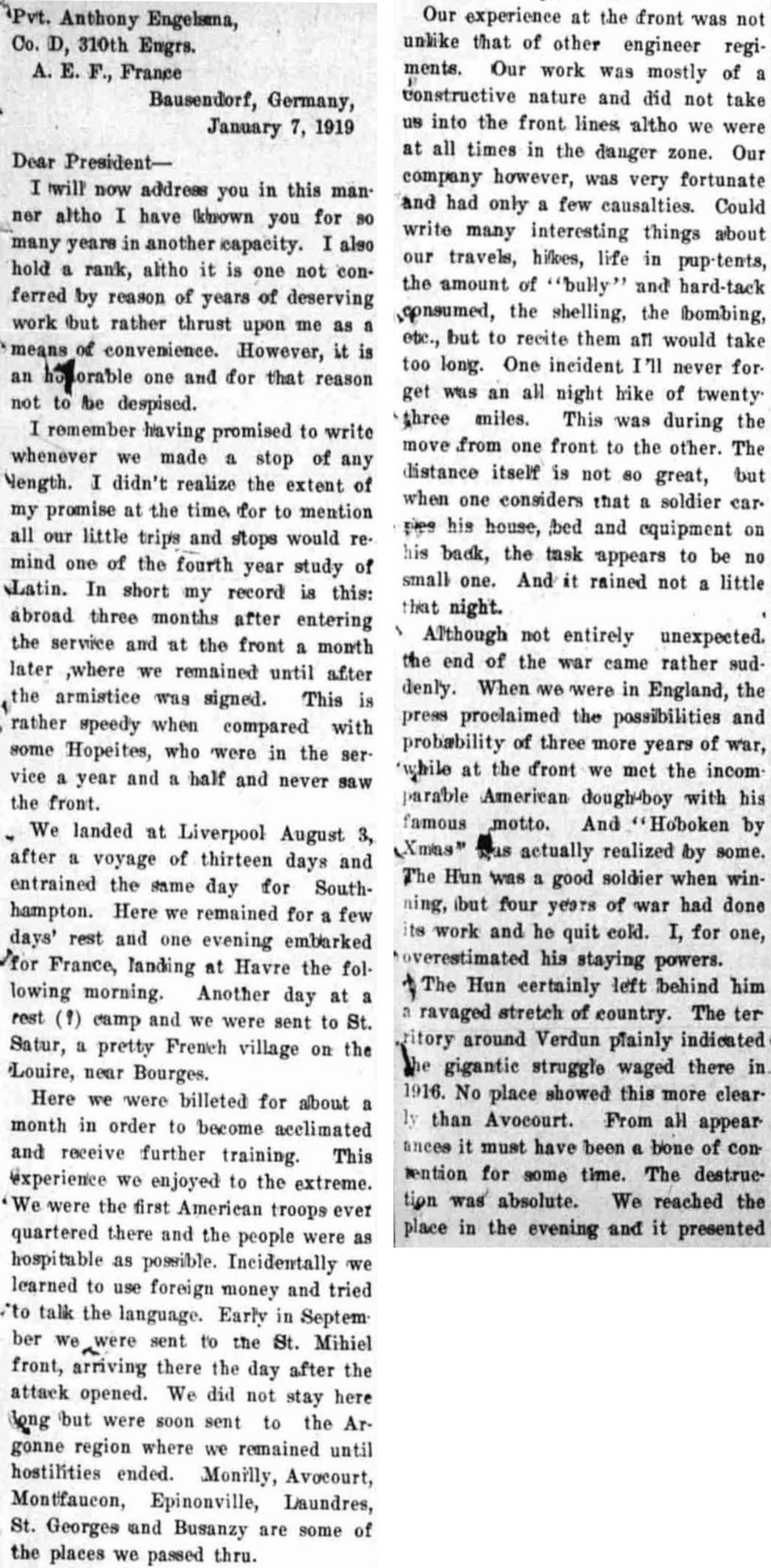
Hope College The Anchor, February 19th 1919
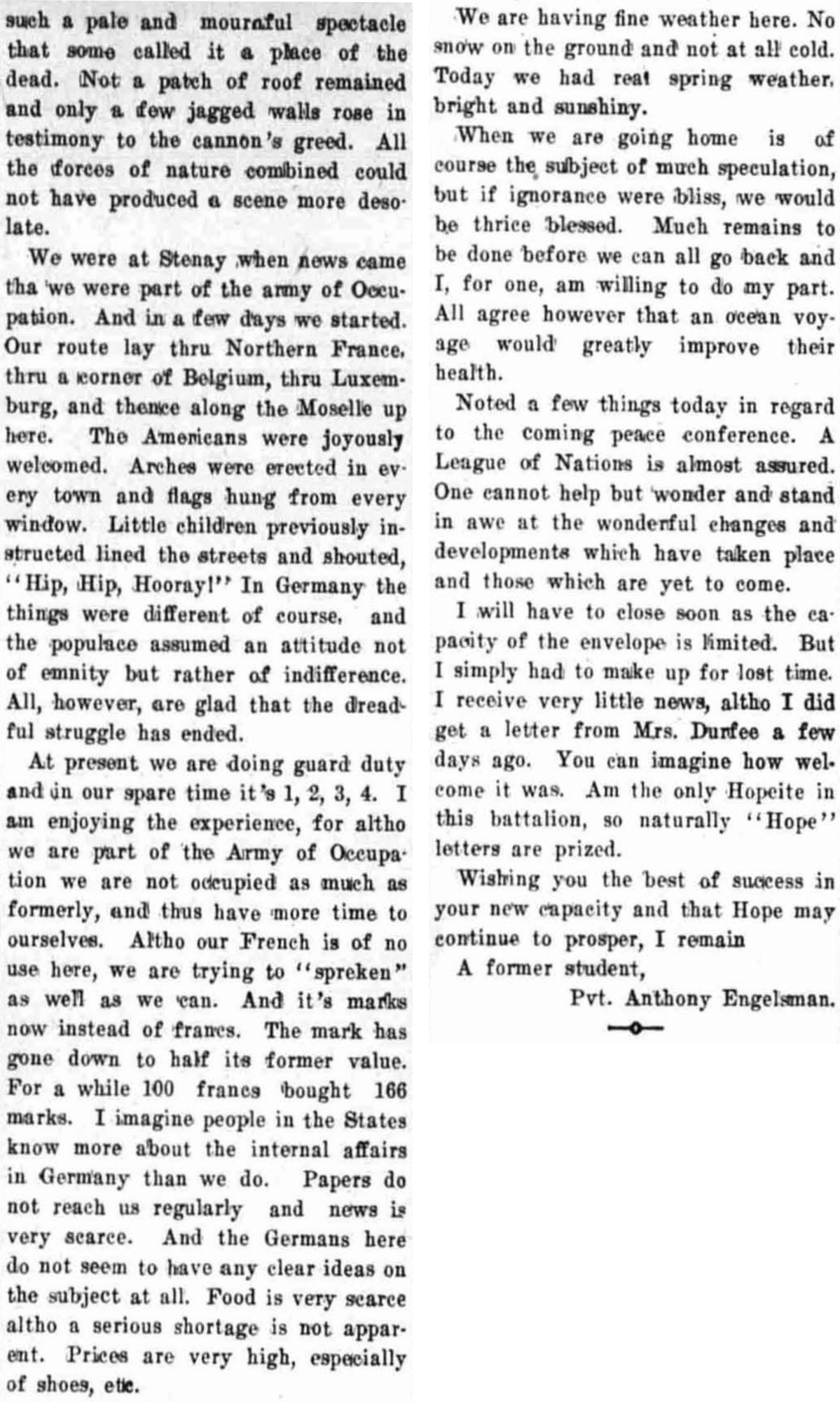
Hope College The Anchor, February 19th 1919
Leaving Europe
In April of 1919, Pvt. Anthony Engelsman was listed as sick and wounded with chronic gastritis and ordered back to the United States. From a port in Saint-Nazaire, France on the USS DeKalb, a former German mail ship converted to a US troop transport, Pvt. Engelsman left Europe on April 7th, 1919.
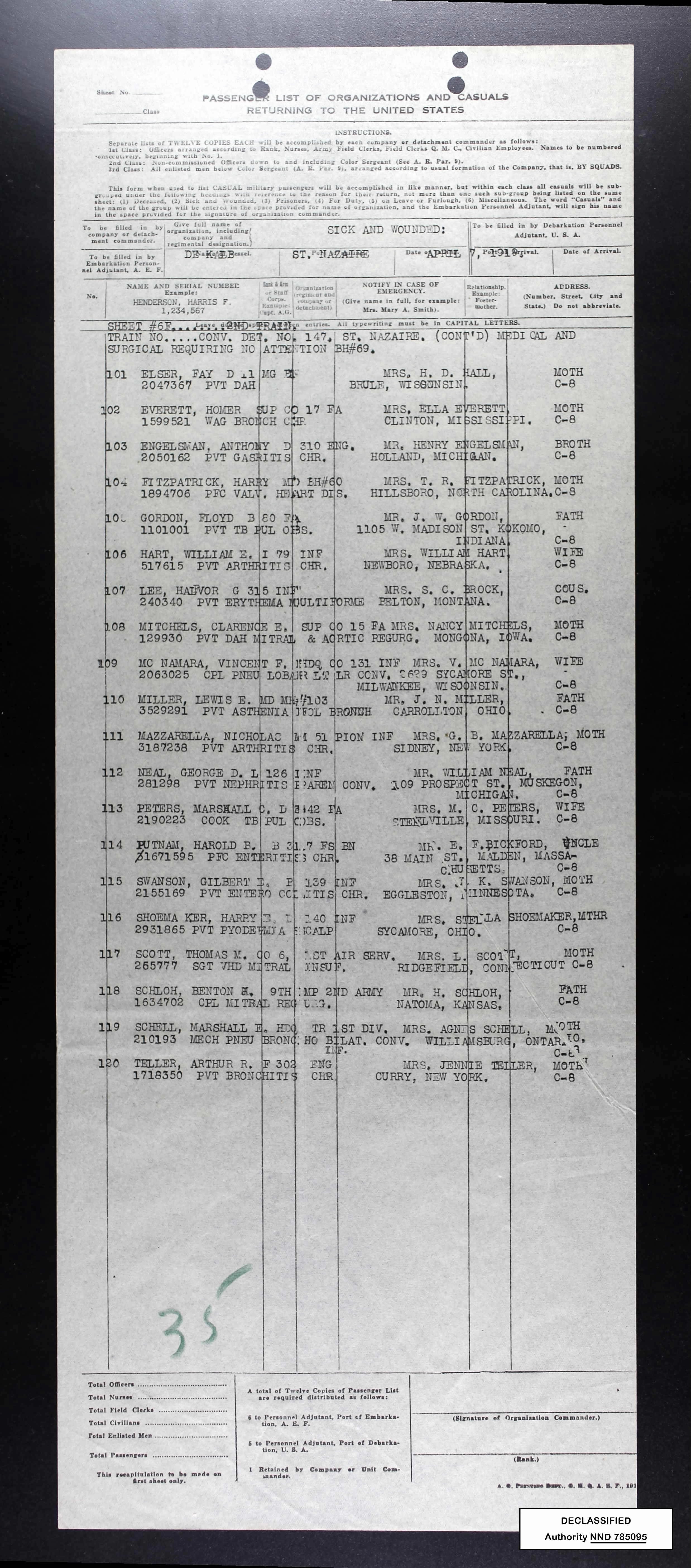
Passenger List of Organizations and Casual Returning to the United States, April 1919
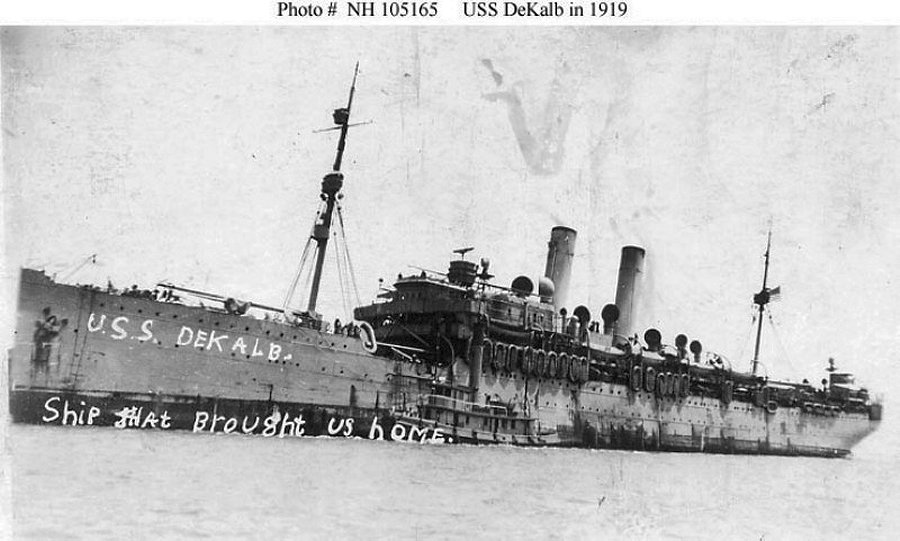
USS DeKalb (ID 3010), 1919
Not Forgotten At Hope
Some time around his return from Europe while still in the Army, Pvte. Anthony Engelsman was listed in the Hope College Honor Roll in the 1919 school yearbook.
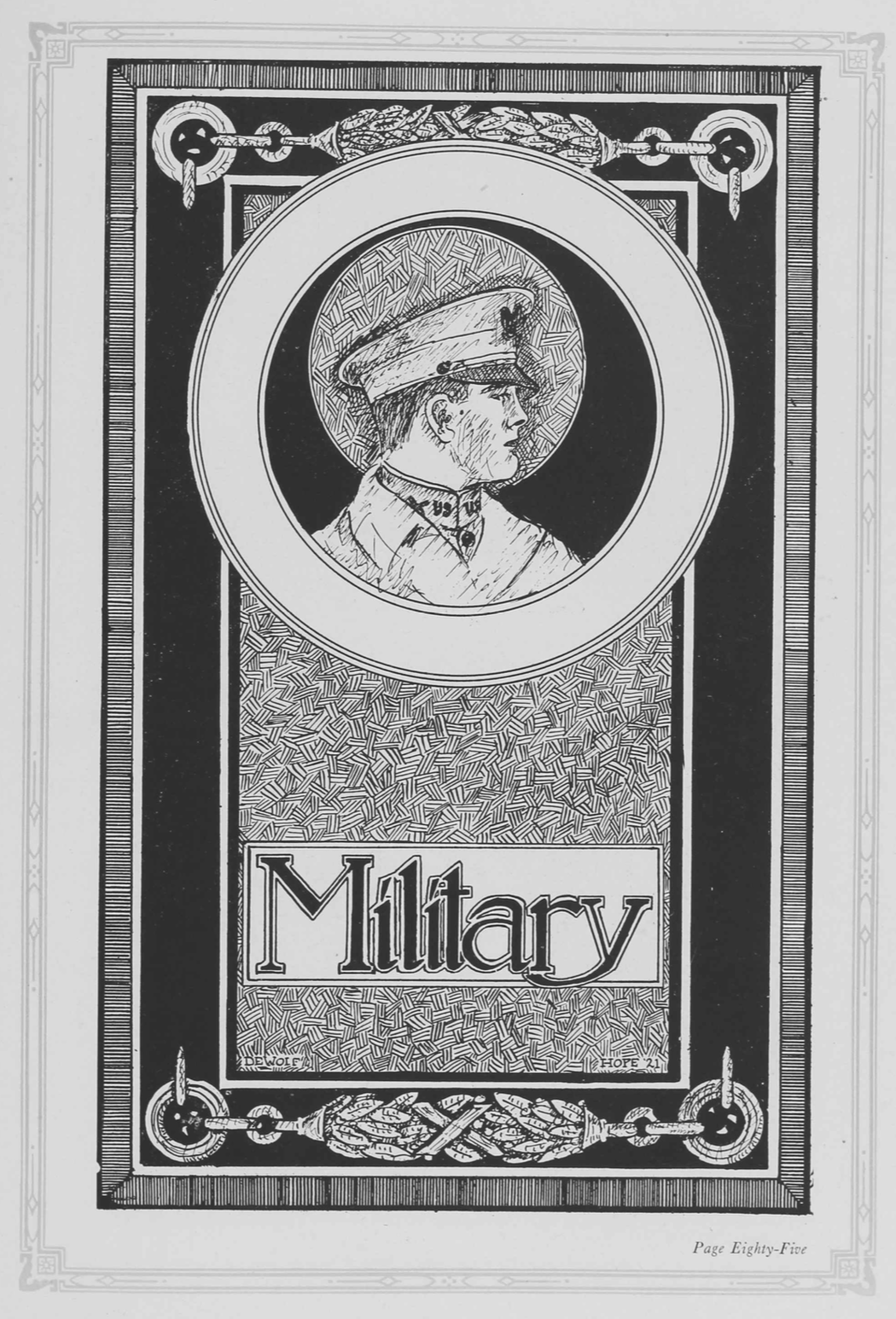
Hope College Milestone, 1919
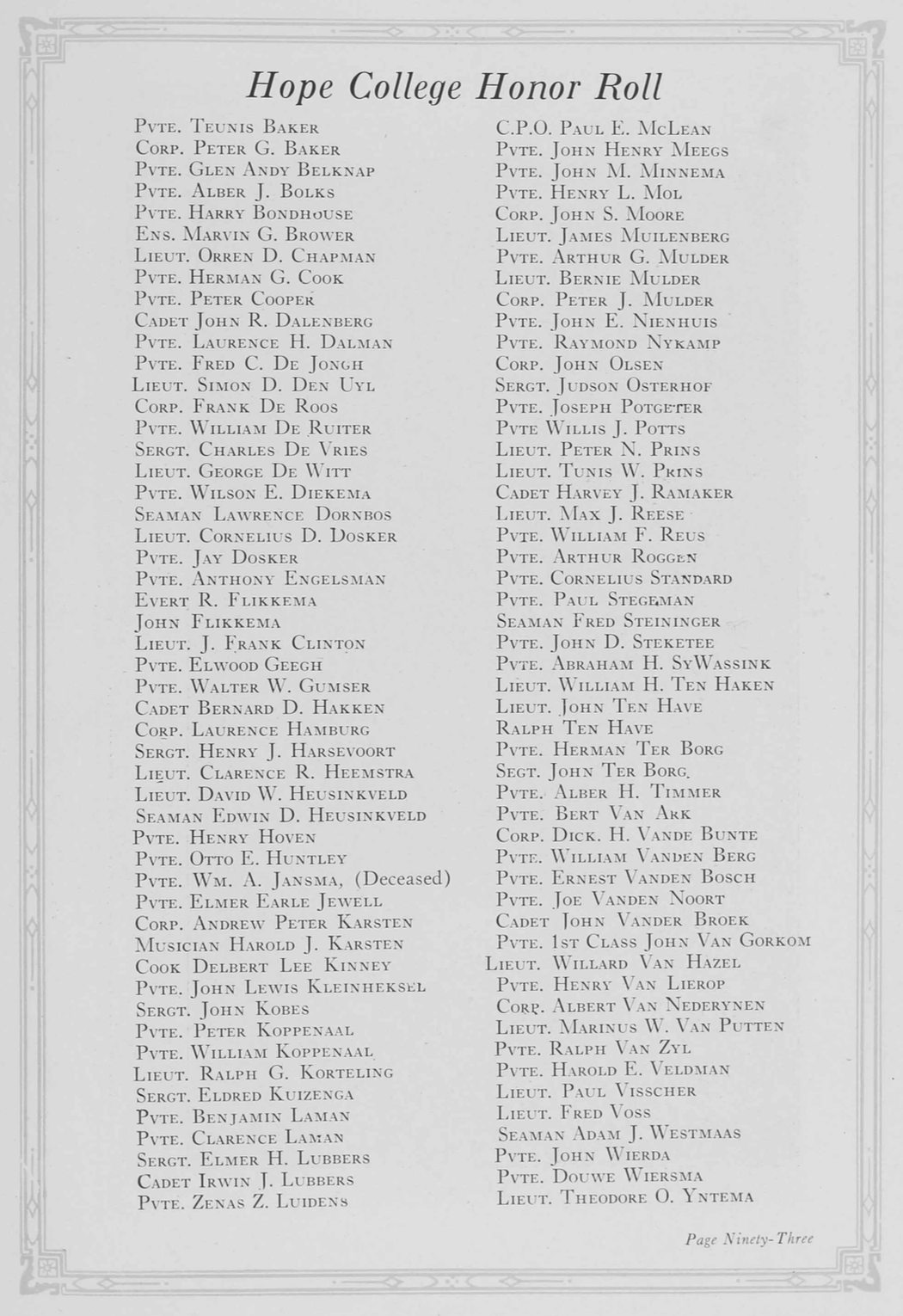
Hope College Milestone, 1919
Leaving The Army
On June 6th, 1919, three months after leaving the shores of Europe, Anthony Engelsman was released from the United States Army.
History Of The 85th At War
A military document dated March 1921 provides additional information on the actions of the 85th Infantry Division during World War I, which includes information on the 310th Engineers Regiment, Company D, in which Pvt. Anthony Engelsman served. This includes involvement in the St. Mihiel offensive and the Meuse-Argonne offensive, as well as serving in the Army of Occupation in Germany.
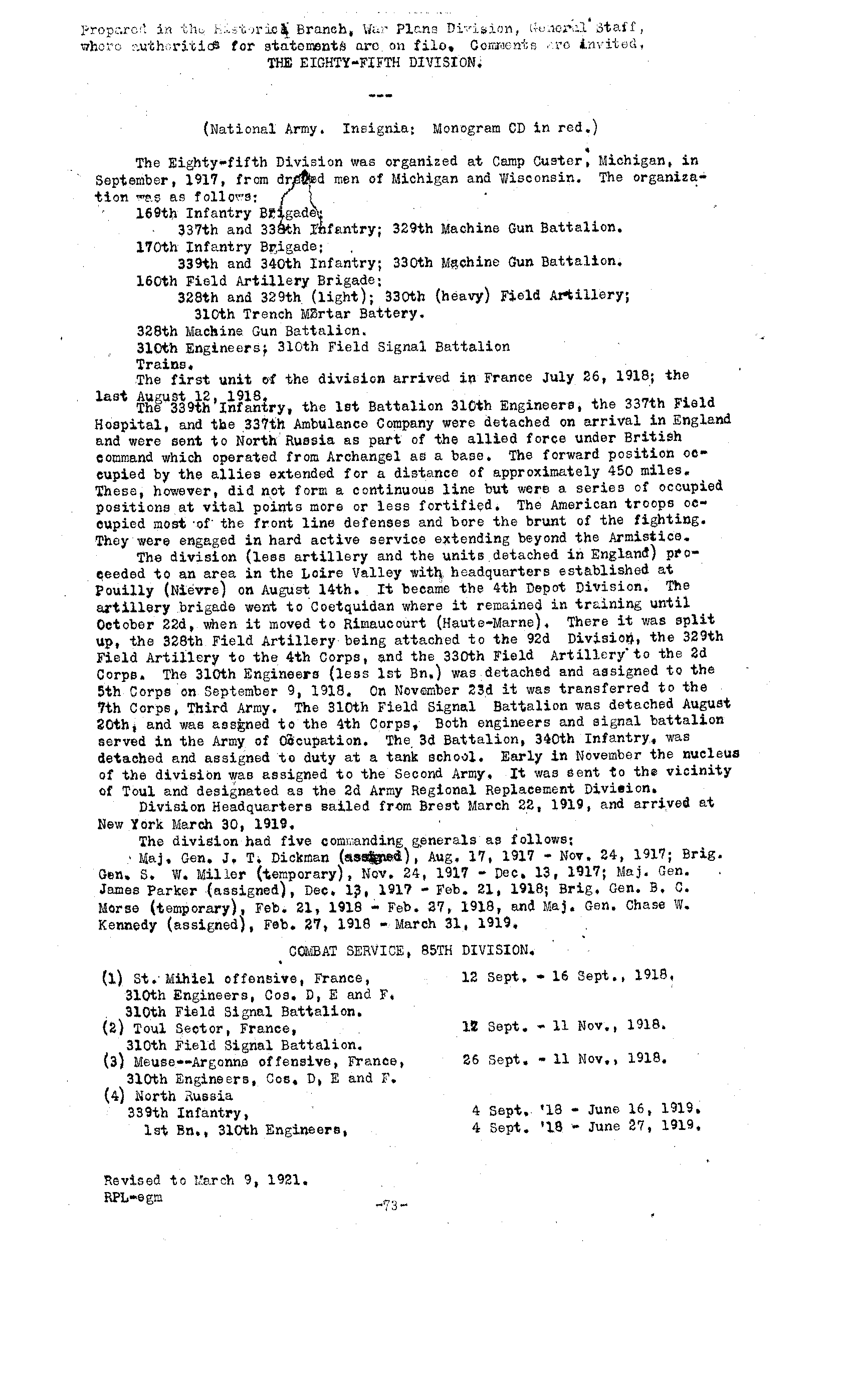
US Army Historical Branch War Plans Division, March 9th 1921
Returning To Hope As A Sophomore
Anthony Engelsman likely returned to Hope College starting in the fall of 1919. The 1920 yearbook lists Anthony as a member of the Fraternal Society and the Debate Team (arguing the negative), as well as winning a debate prize in June of 1920, one year after leaving the military.
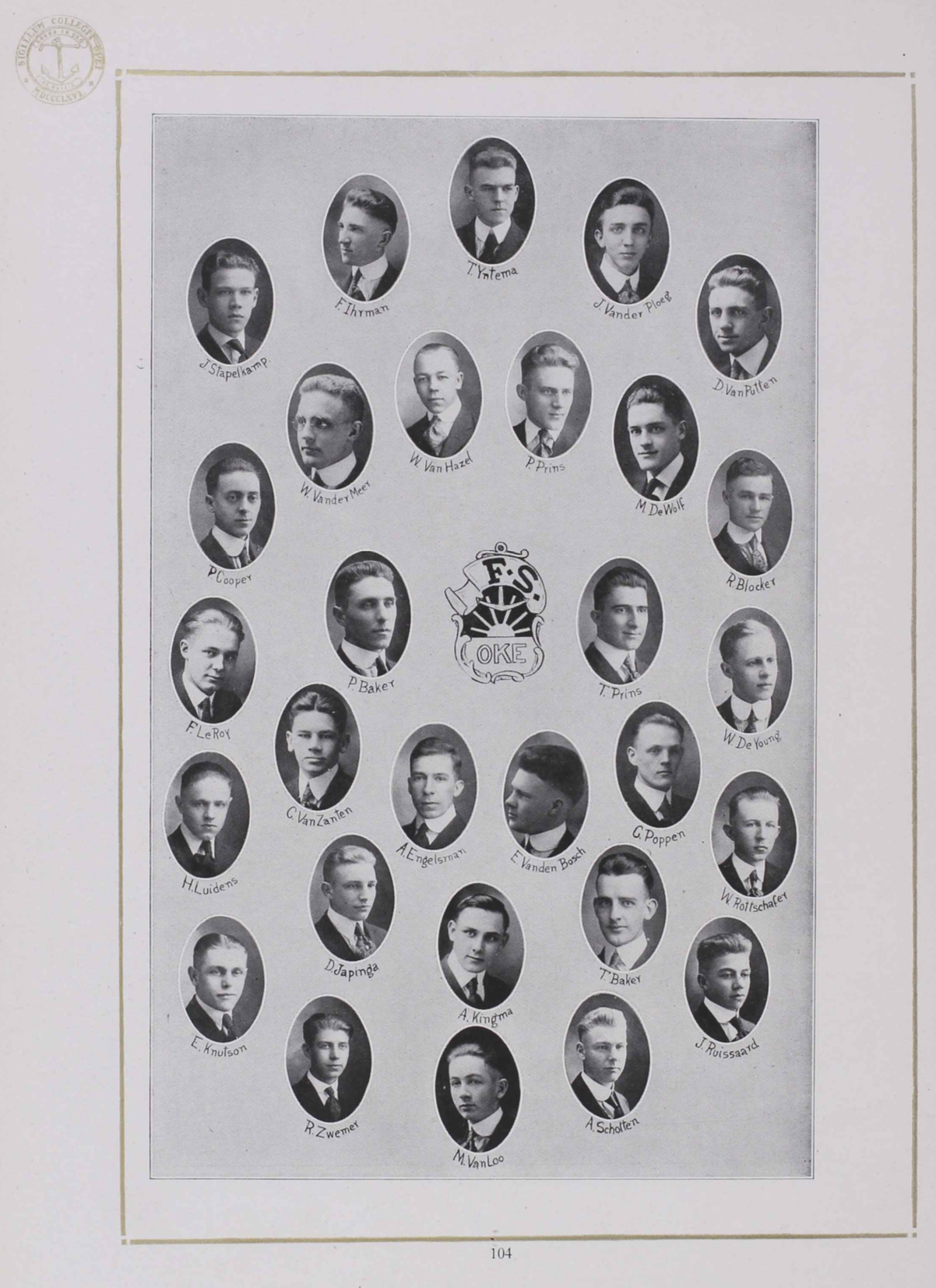
Hope College Milestone, 1920

Hope College Milestone, 1920
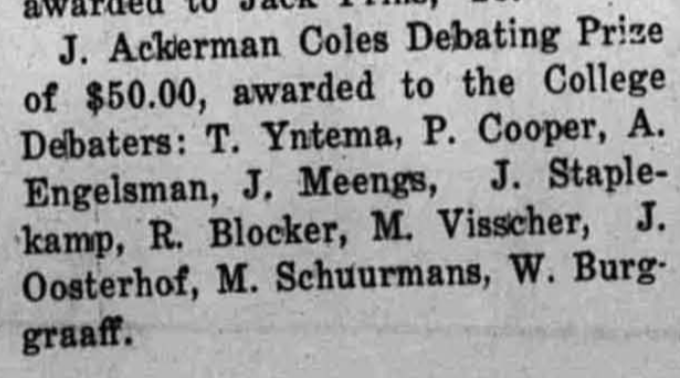
Hope College The Anchor, June 17th, 1920
Junior Year At Hope
Anthony continued at Hope College the following year as a junior, a member of Pi Kappa Delta, the Fraternal Society and the Debate Team.

Hope College Milestone, 1921
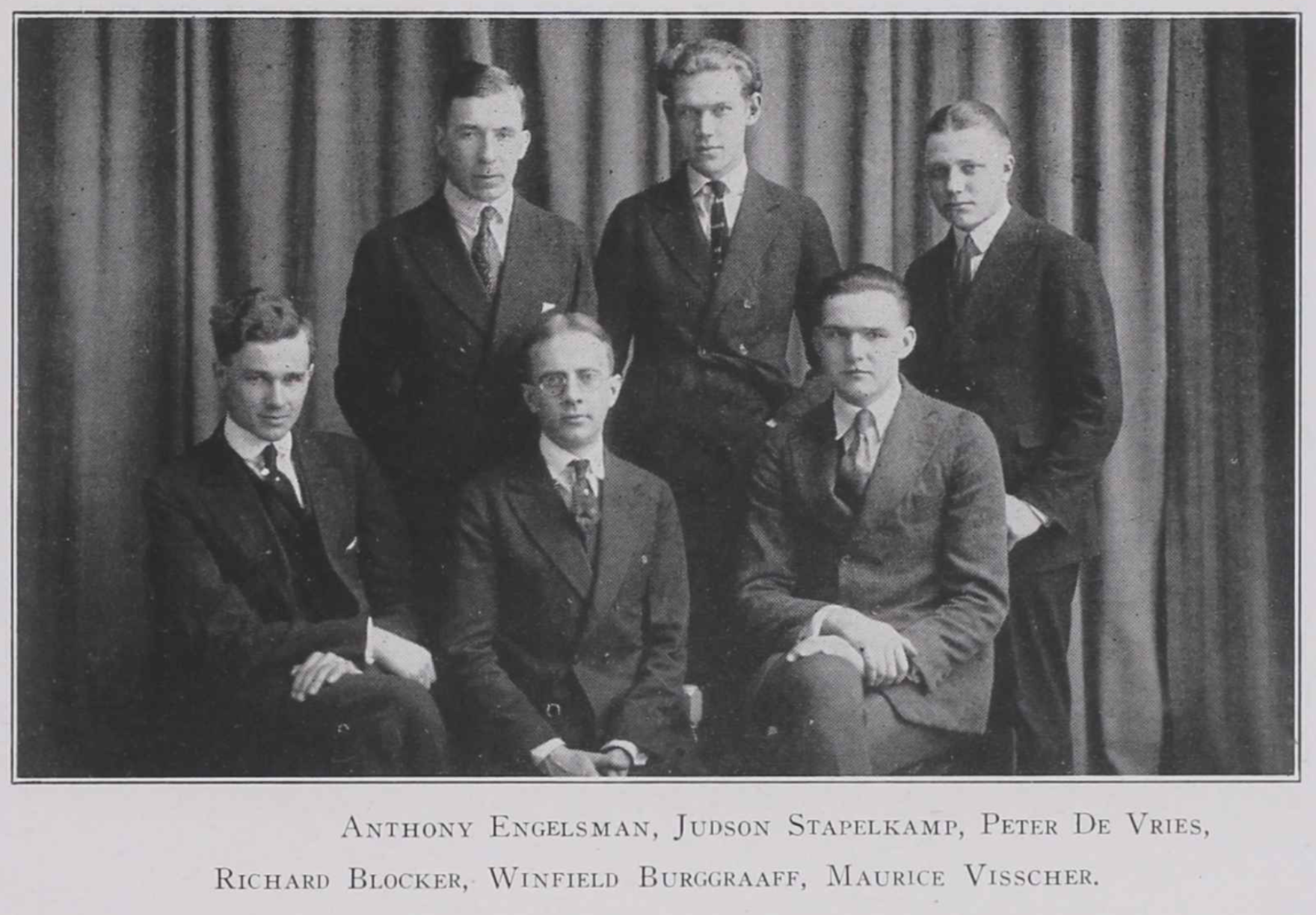
Hope College Milestone, 1921

Hope College Milestone, 1921
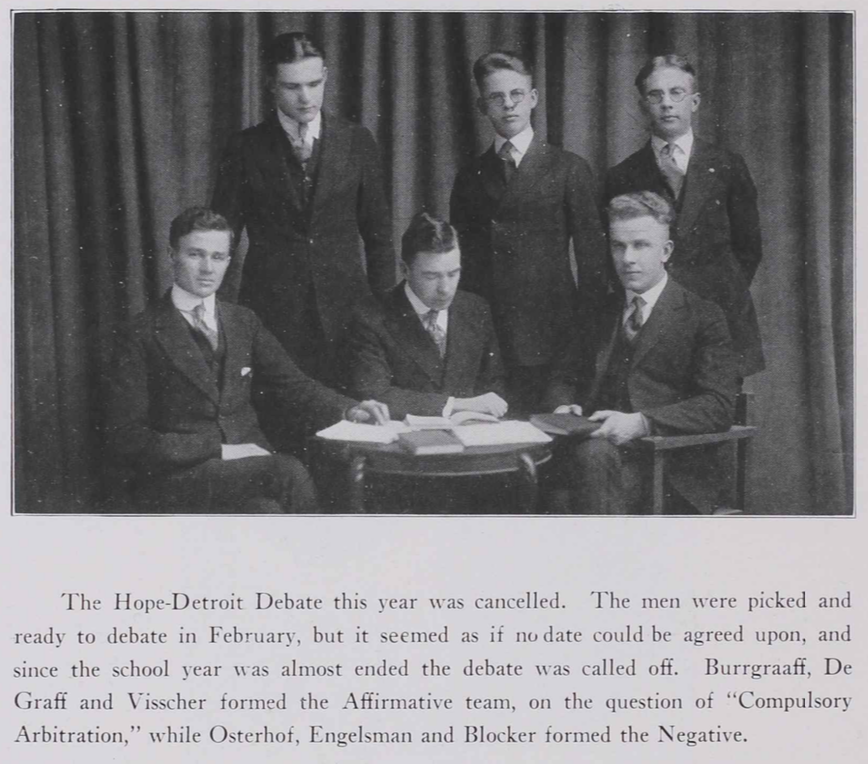
Hope College Milestone, 1921
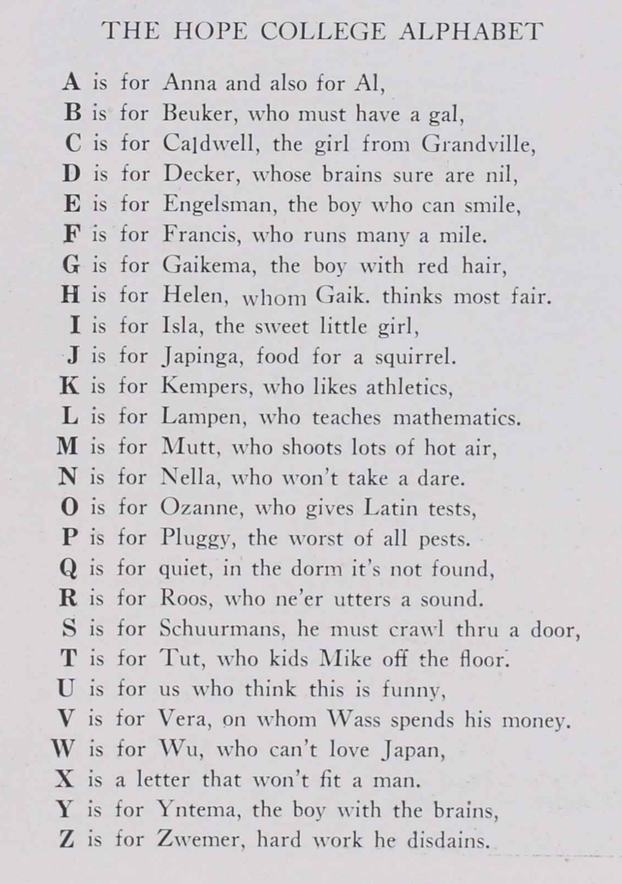
Hope College Milestone, 1921
“Our Girls And Tony Engelsman”
At a student gathering at a cottage in the fall of 1921, soon after starting senior year at Hope College, Anthony Engelsman and the girls at the gathering prepared “a fine spread”.
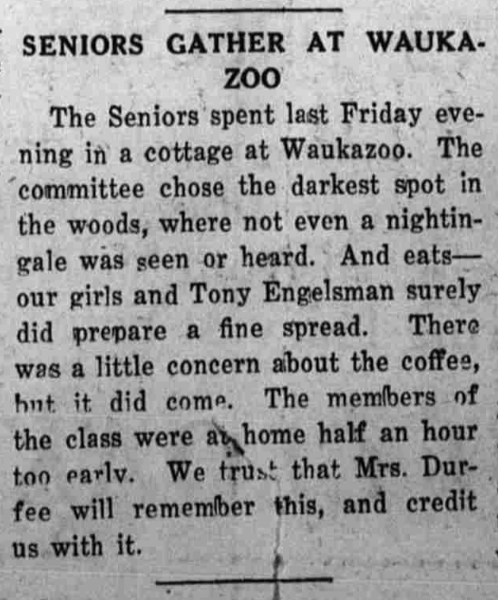
Hope College The Anchor, October 5th 1921
For All Hope
Later that fall, Anthony wrote a rebuttal to a previous editorial in The Anchor student newspaper, apparently in regards to a kerfuffle that occurred between a group of senior class students and a group of freshman students.
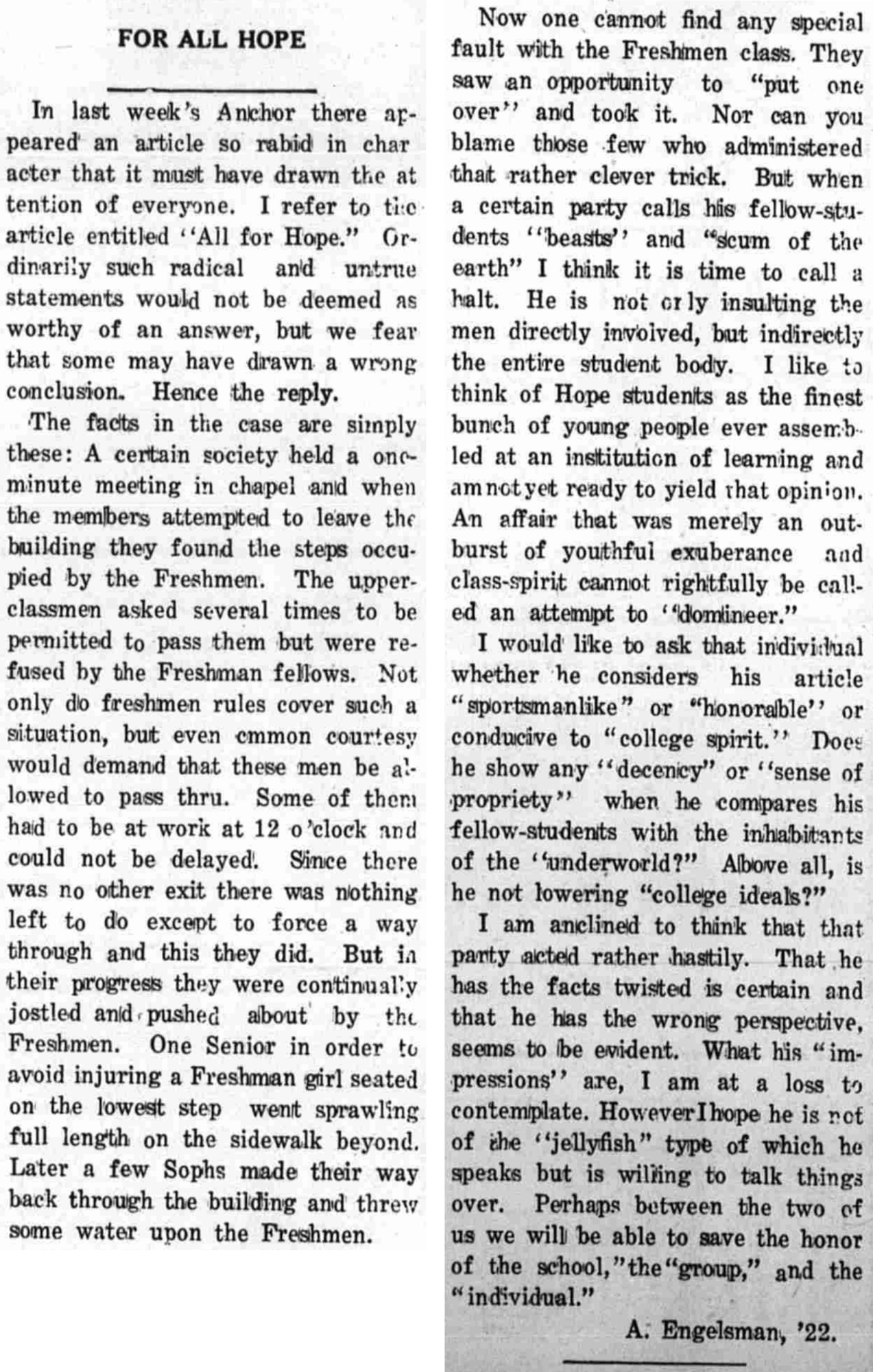
Hope College The Anchor, November 16th 1921
Senior Year At Hope
Anthony Engelsman graduated with a Bachelor of Arts degree from Hope College in 1922. During his senior year, he was secretary of the Fraternal Society as well as a member of the Debate Team and Pi Kappa Delta.
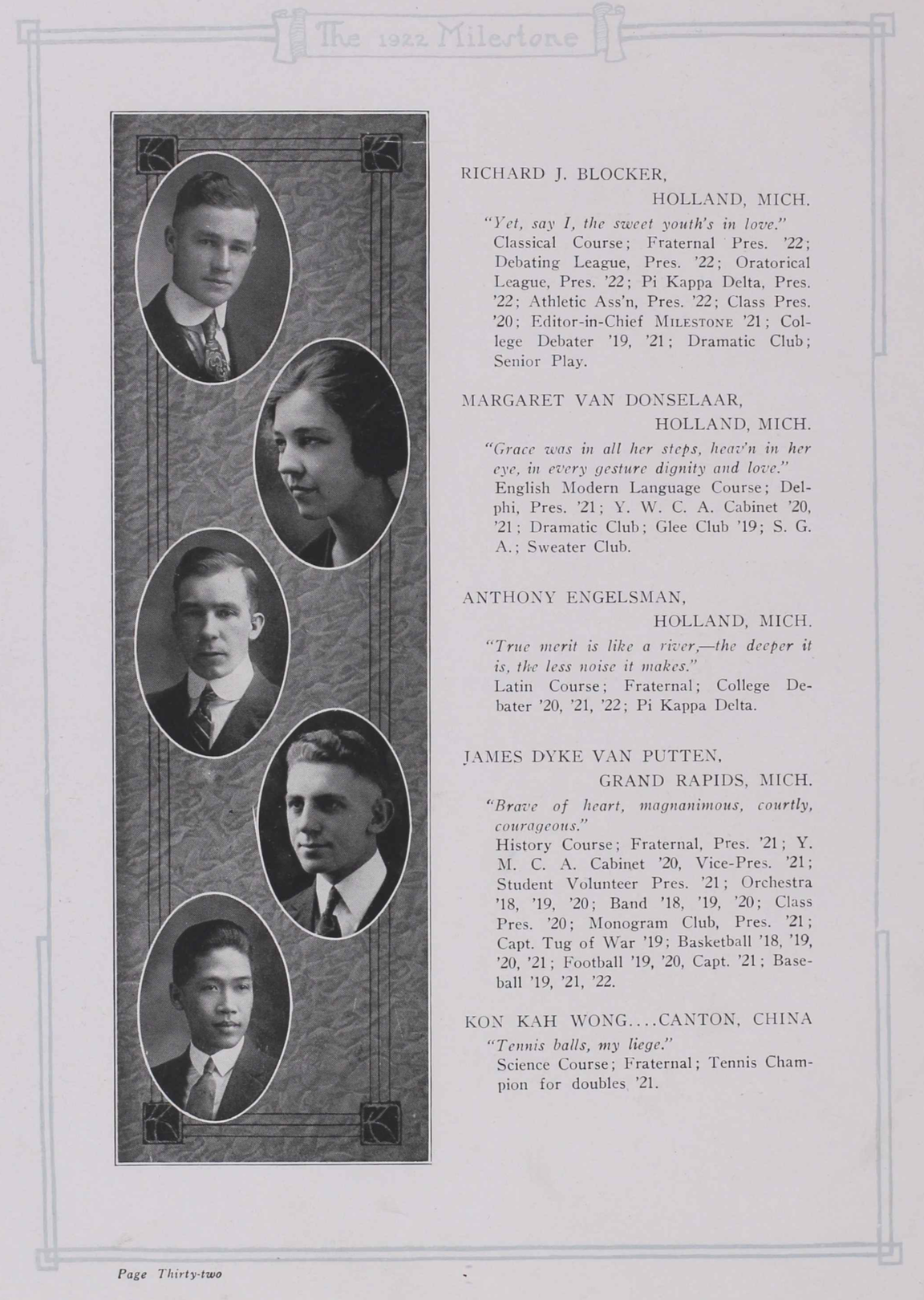
Hope College Milestone, 1922
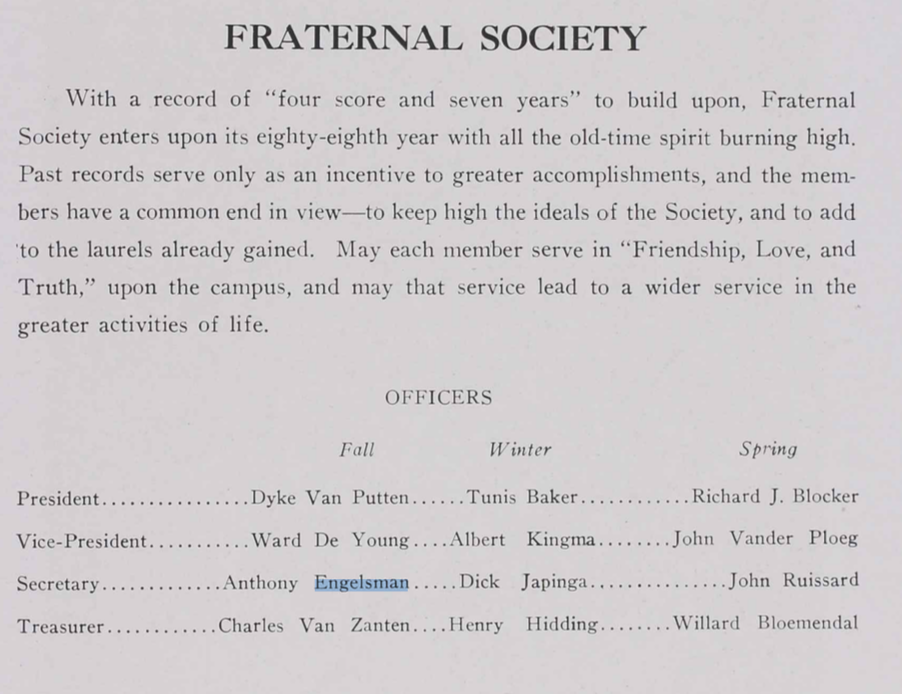
Hope College Milestone, 1922
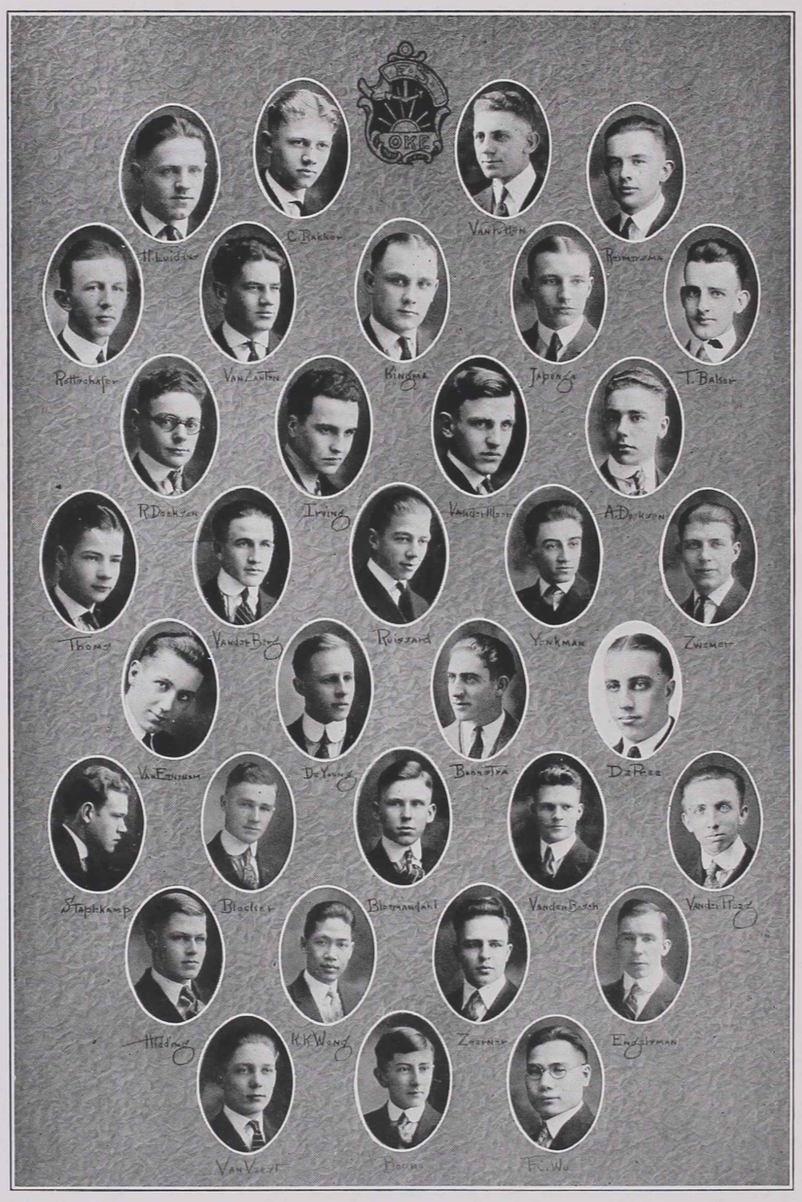
Hope College Milestone, 1922
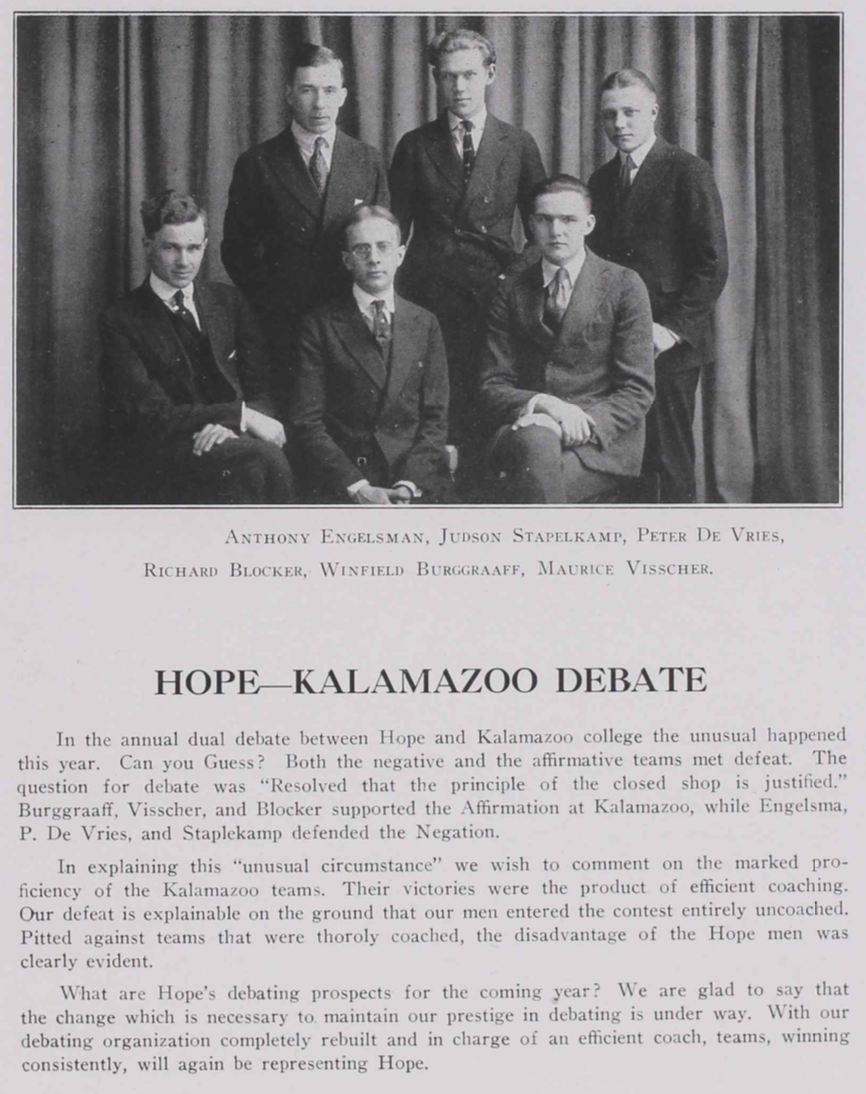
Hope College Milestone, 1922
After College
After graduating from Hope College with a Bachelor of Arts in History, Anthony Engelsman would then go on to graduate studies at the University of Michigan. However, it is unclear when Anthony began and completed his graduate studies at the university.
Graduate Studies
In the 1925 general register for the summer session at the University of Michigan, Anthony’s name is listed as a graduate student in the College of Education.

University of Michigan General Register, 1925
The following year’s November 1926 proceedings of the board of regents then lists Anthony Engelsman as receiving both a teacher’s certificate and a Master’s of Art degree.
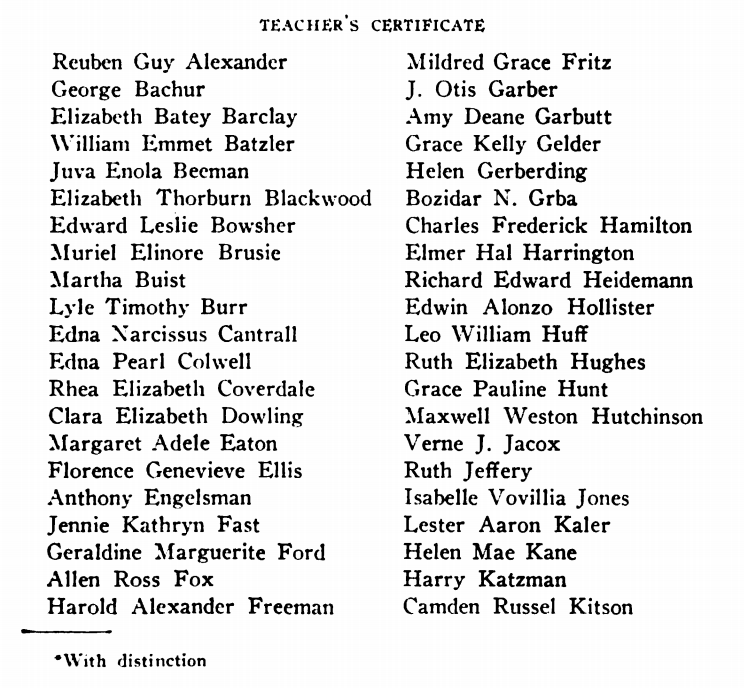
University of Michigan Board Meeting, 1926
High School Teacher
By 1931, Anthony Engelsman was a high school English teacher in Ypsilanti, Michigan according to an alumni note in the 1931 edition of the Hope College Milestone yearbook.
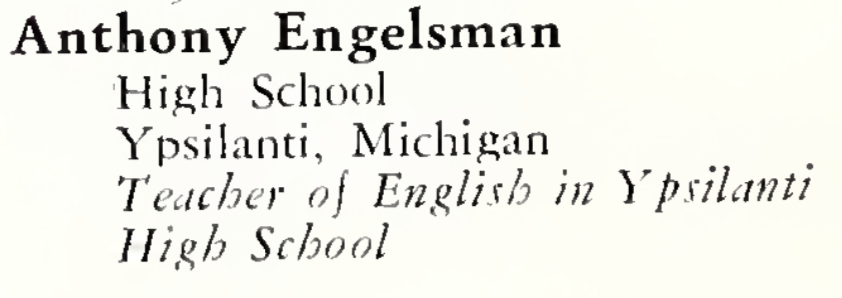
Hope College Milestone, 1931
Veteran Scholarship
Two years later in a December 1933 board meeting at the University of Michigan, Anthony Engelsman was awarded a 1933-1934 United States Army Veteran Scholarship for additional studies at the university.

University of Michigan Board Meeting, December 1933
He received the same award the following 1934-1935 school year as well.

University of Michigan Board Meeting, November 1934
Failure To Register
However, it appears that he did not register for courses in the 1934-1935 school year, as recorded in a March 1935 board meeting.

University of Michigan Board Meeting, March 1935
The following year, his name is listed as a recipient of the scholarship in an April 1936 board meeting, but a record of his graduation was not found. It is unclear what degree Anthony Engelsman was pursuing with the United States Army Veteran Scholarship or whether he completed such a degree.
Professor Engelsman
By 1940, Anthony Engelsman he become an Assistant Professor in History at Michigan State Normal College in Ypsilanti, Michigan outside Ann Arbor, teaching courses on state, local and comparative government.
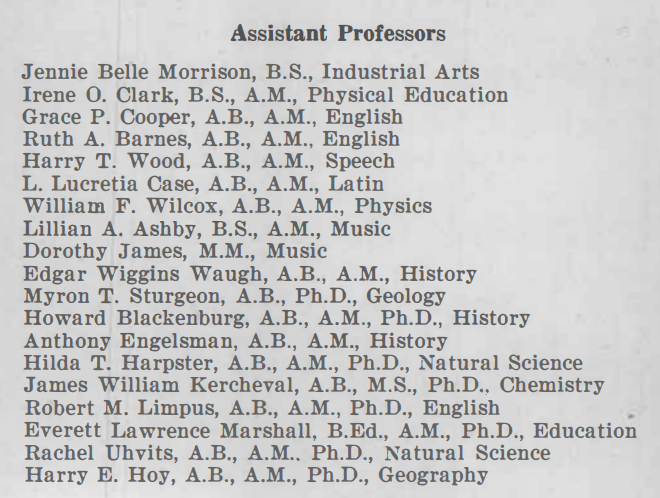
Michigan State Normal College Bulletin, March 1940
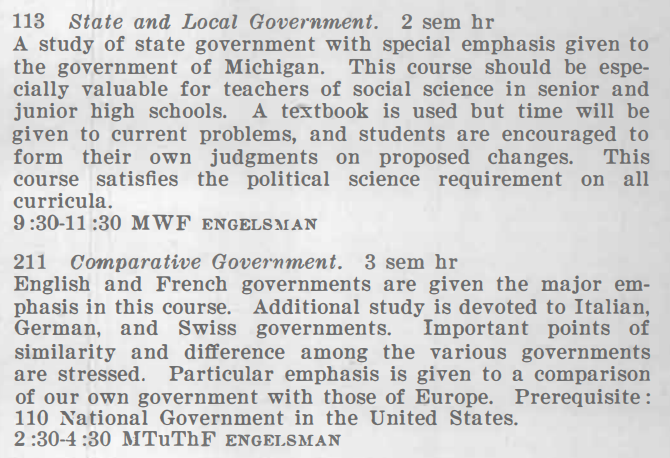
Michigan State Normal College Bulletin, March 1940
Old Man’s Registration
On September 16th, 1940, President Franklin D. Roosevelt signed into law the Selective Training and Service Act of 1940, the first peacetime conscription in U.S. history.
Following the Japanese attack at Pearl Harbor in December of 1941, which propelled the United States into World War II, the act authorized the military to conduct what would total six registrations during the war. The fourth registration, referred to as the “Old Man’s Registration”, was used to gather information about the industrial capability about men born between April 27, 1877 and February 16, 1897.
On April 27th, 1942, at the age of 48, Anthony Engelsman registered in the Selective Service for the second time in his life.
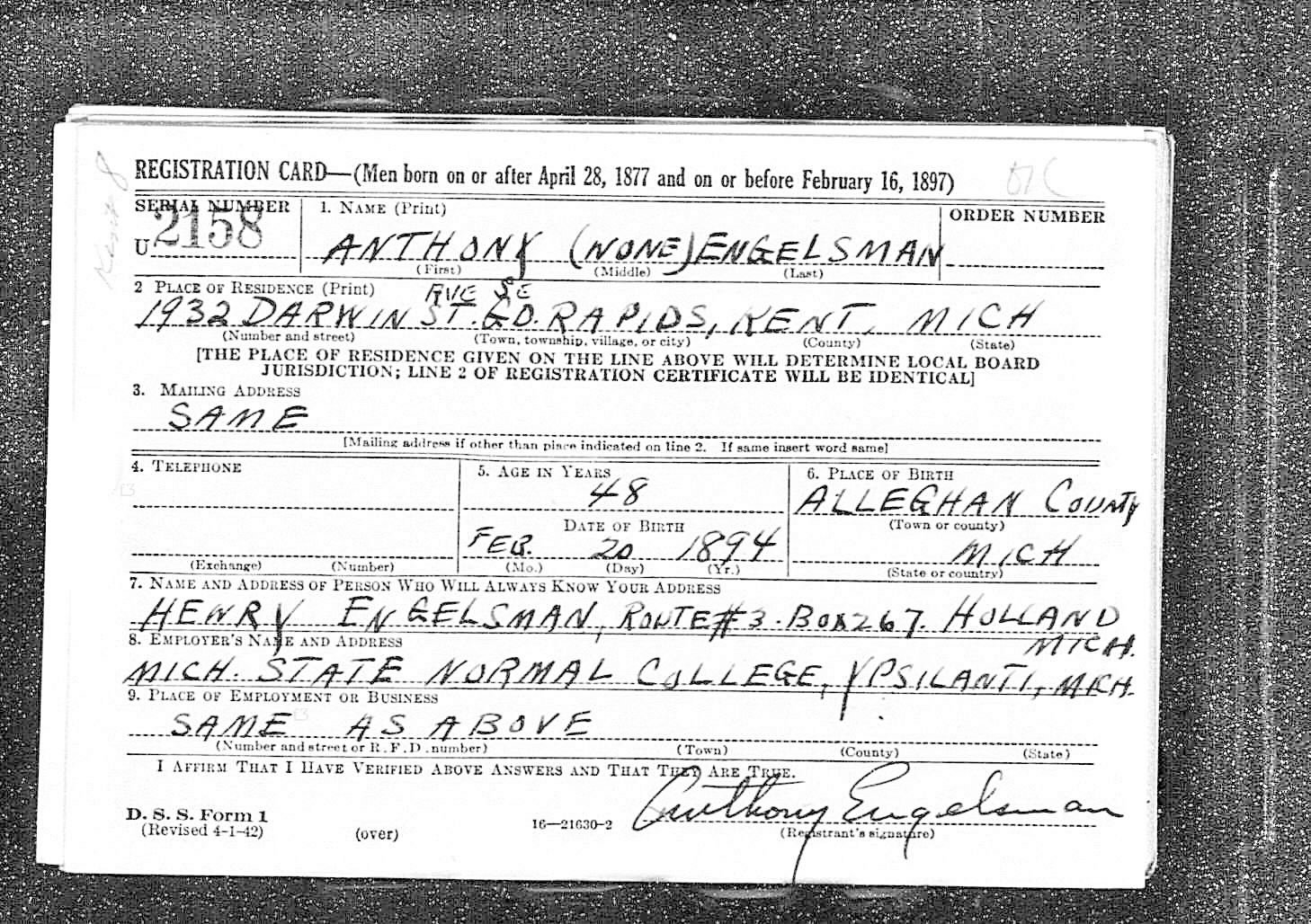
U.S. Selective Service Registration Card, 1942
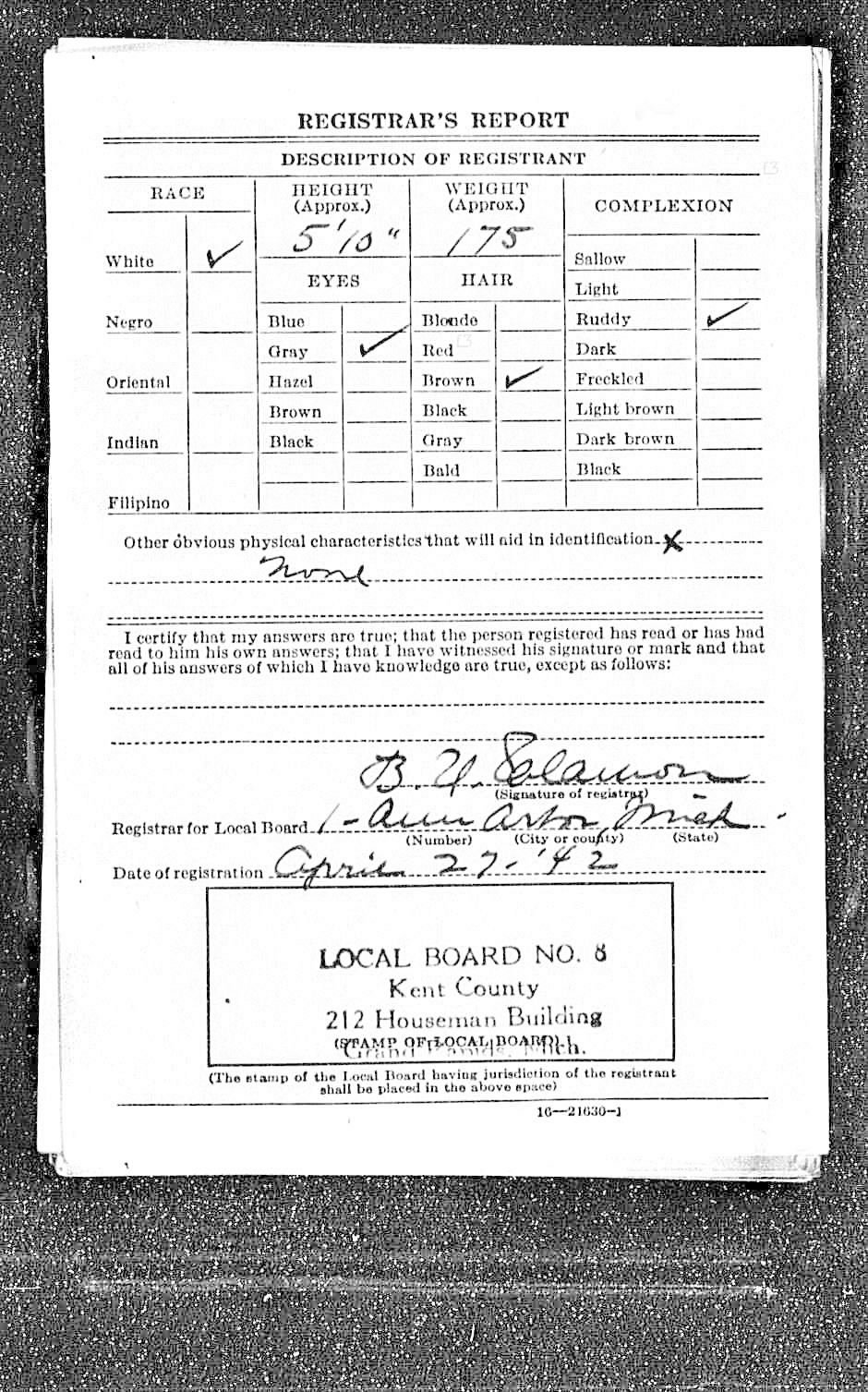
U.S. Selective Service Registration Card, 1942
World War II
While he was required to register for the Selective Service, there’s no indication that Anthony Engelsman was called upon for national service during World War II.
On June 6th, 1944, the United States entered the European Theater of World War II, storming the shores of Normandy, France on D-Day. It had been only twenty-six years since Anthony Engelsman had arrived at similar shores of France during his service in World War I.
A year later, World War II in Europe was over as of May 8th, 1945, also known as V-E Day.
Political Science
By 1949, Prof. Engelsman was teaching Political Science instead of History. And by 1955, he had become an Associate Professor. Seven years later in 1962, he was still an Associate Professor at the recently renamed Eastern Michigan University.

Eastern Michigan University Bulletin, January 1962
Within the next two years, he had achieved tenure as a Full Professor of Political Science.

Eastern Michigan University Bulletin, June 1964
And the following year, he began teaching both History and Political Science.
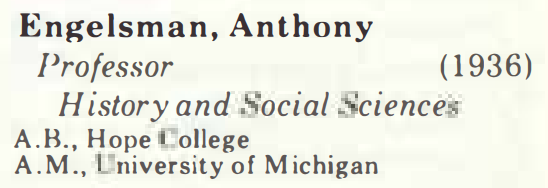
Eastern Michigan University Bulletin, September 1965
Death
After a serving his country in World War I and after a long career as a professor of history and political science, Anthony Engelsman died on May 9th, 1984 at the age of 90 in Zeeland, Michigan. He was buried in Overisel Cemetery, near the hometown where he was raised.
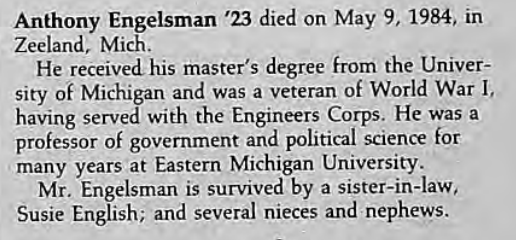
News from Hope College, June 1984
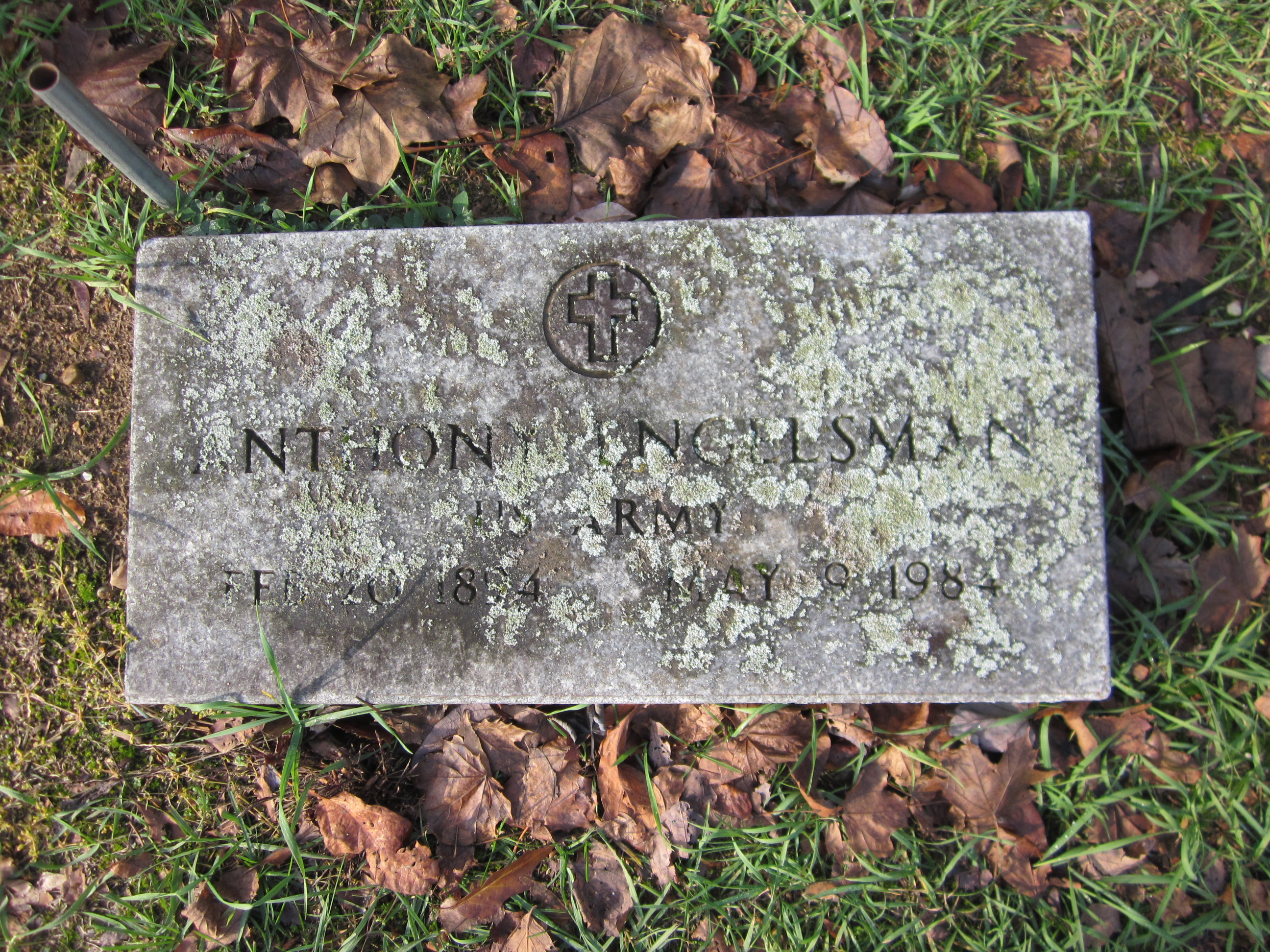
Additional Reading
“We All Must Do Our Utmost:” Holland, Michigan in World War I
Hope College Collection: The Joint Archives of Holland
The US Army Corps of Engineers: A Brief History - World War I
Regional Training Camps: The Case of Camp Custer
A City in Wartime: Hoboken, 1914-1919
Officer Experience Reports
Officers in the 310th Engineers Regiment compiled Experience Reports and sent them to the Chief Engineer of the American Expeditionary Force in December of 1918. A selection of those reports are provided by commanding officers of the regiment as well as lieutenants in Company D (in which Anthony Engelsman was assigned).
These reports are included here to provide additional detail and supplement the first hand account provided by Anthony Engelsman in his letter dated January 7th, 1919.
2nd Lt. Darnce B. Burns, Company D
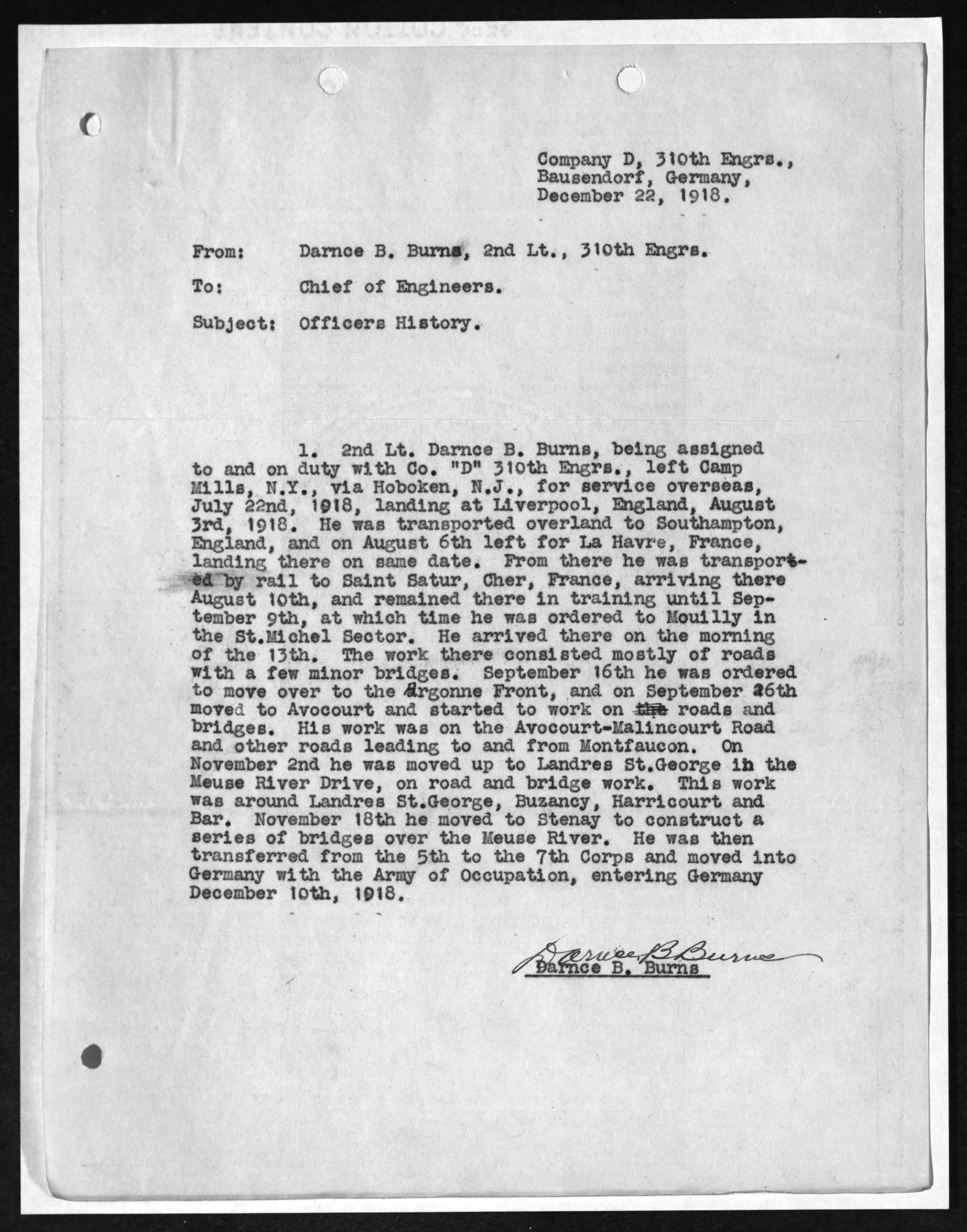
2nd Lt. Darnce B. Burns, December 22nd 1918
2nd Lt. Walter T. Deadrick, Company D
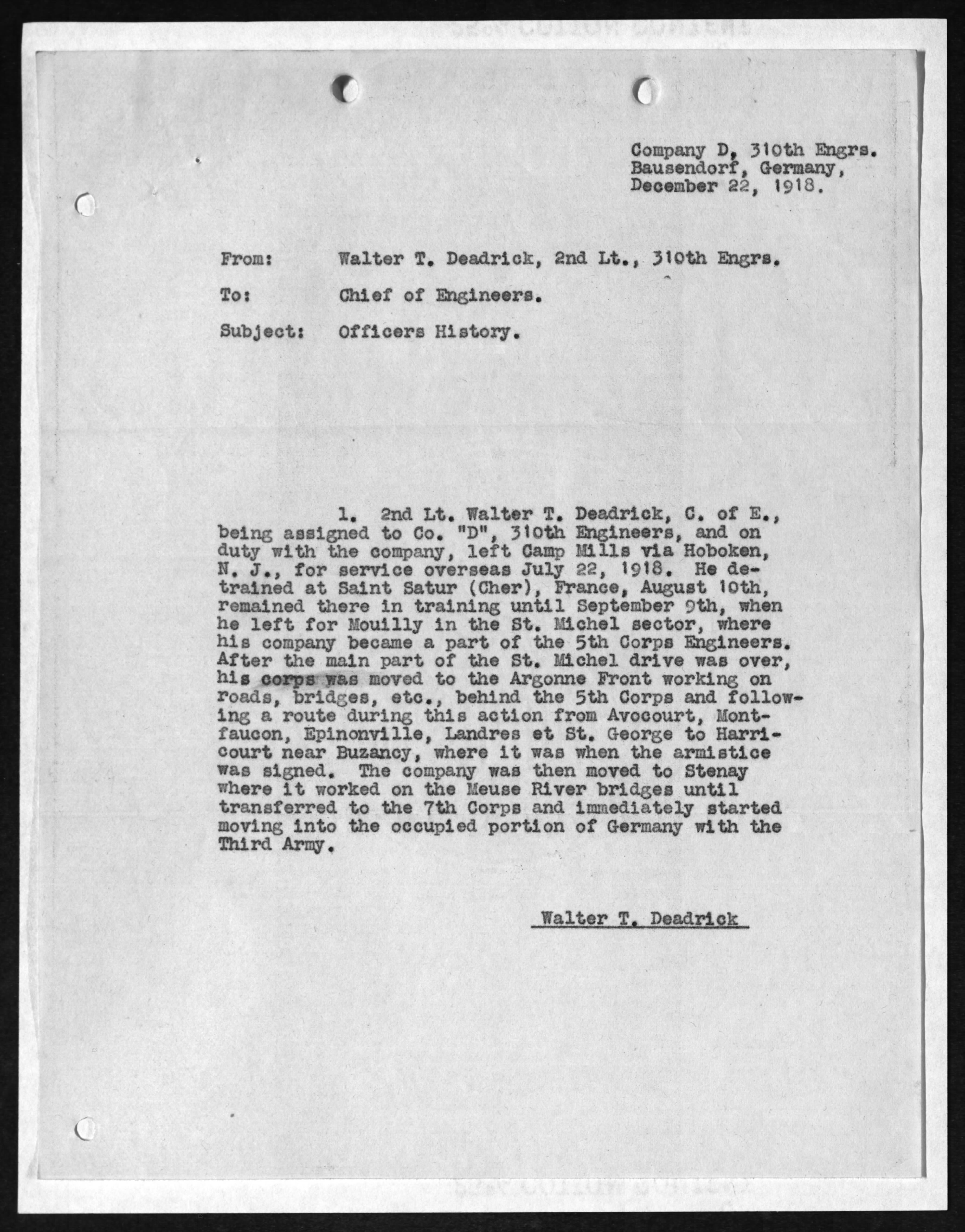
2nd Lt. Walter T. Deadrick, December 22nd 1918
1st Lt. Earl H. Smith, Company D
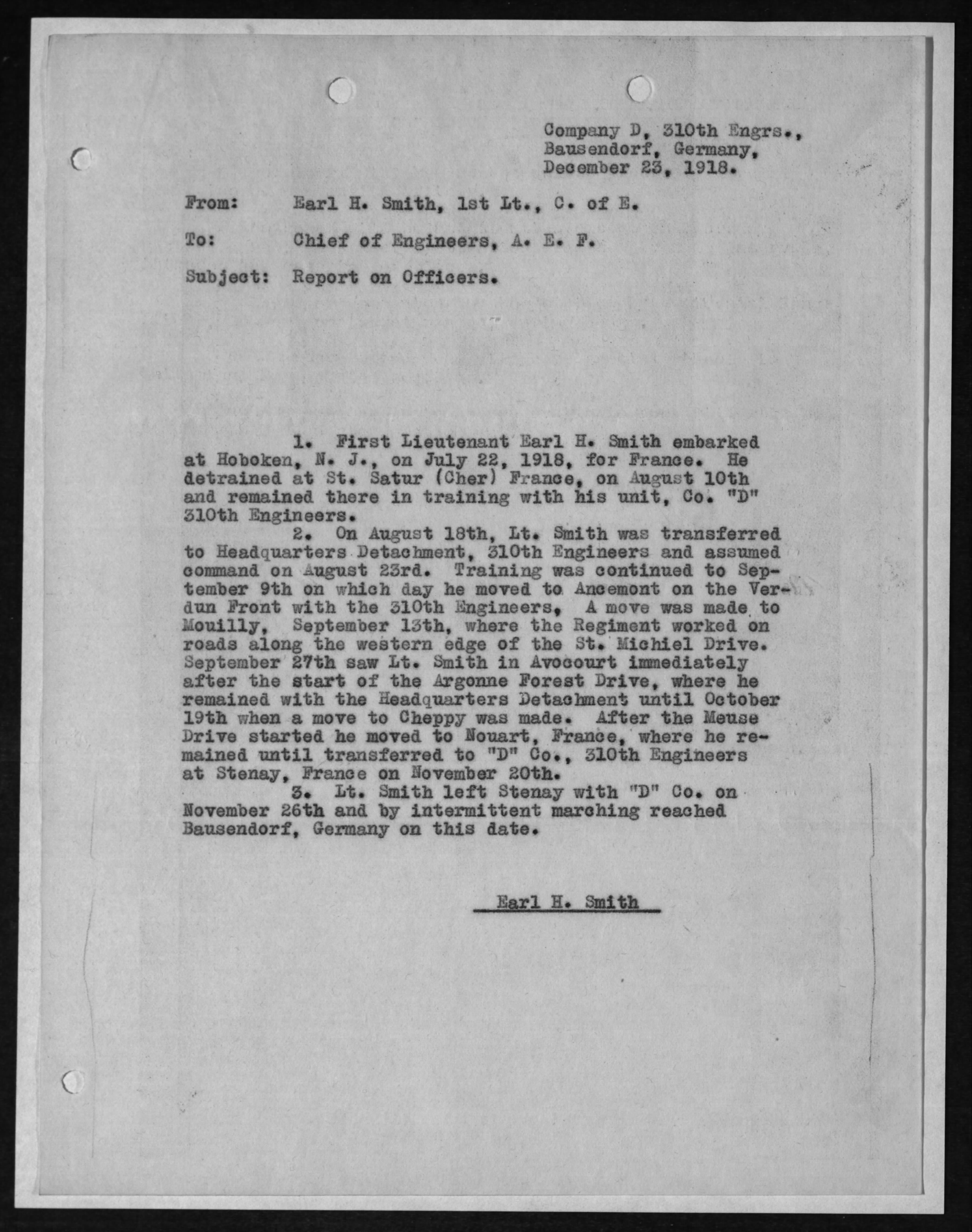
1st Lt. Earl H. Smith, December 23rd 1918
1st Lt. Leon K. Wiese, Company D
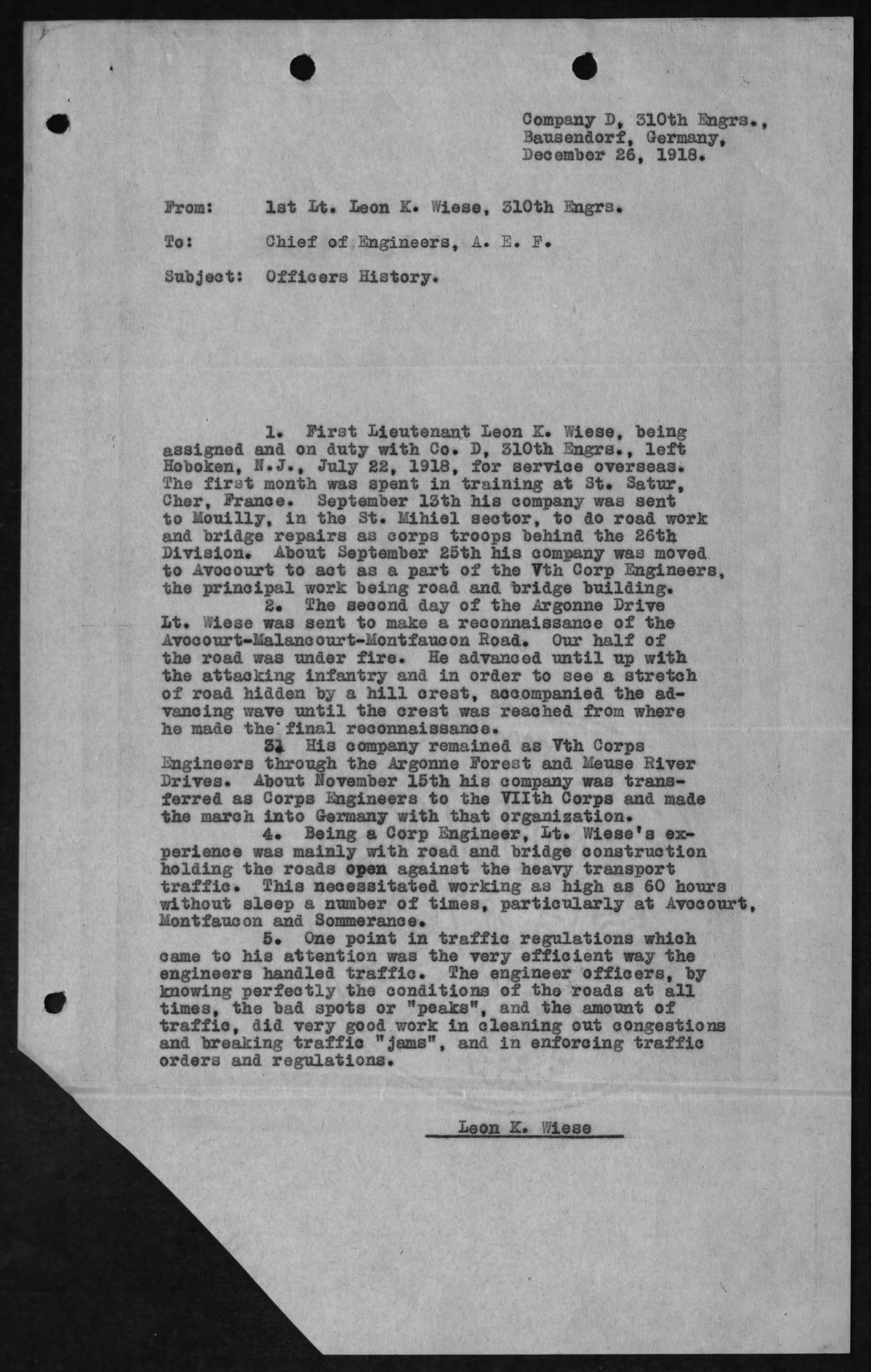
1st Lt. Leon K. Wiese, December 26th 1918
Capt. W. H. Boyer, Company D
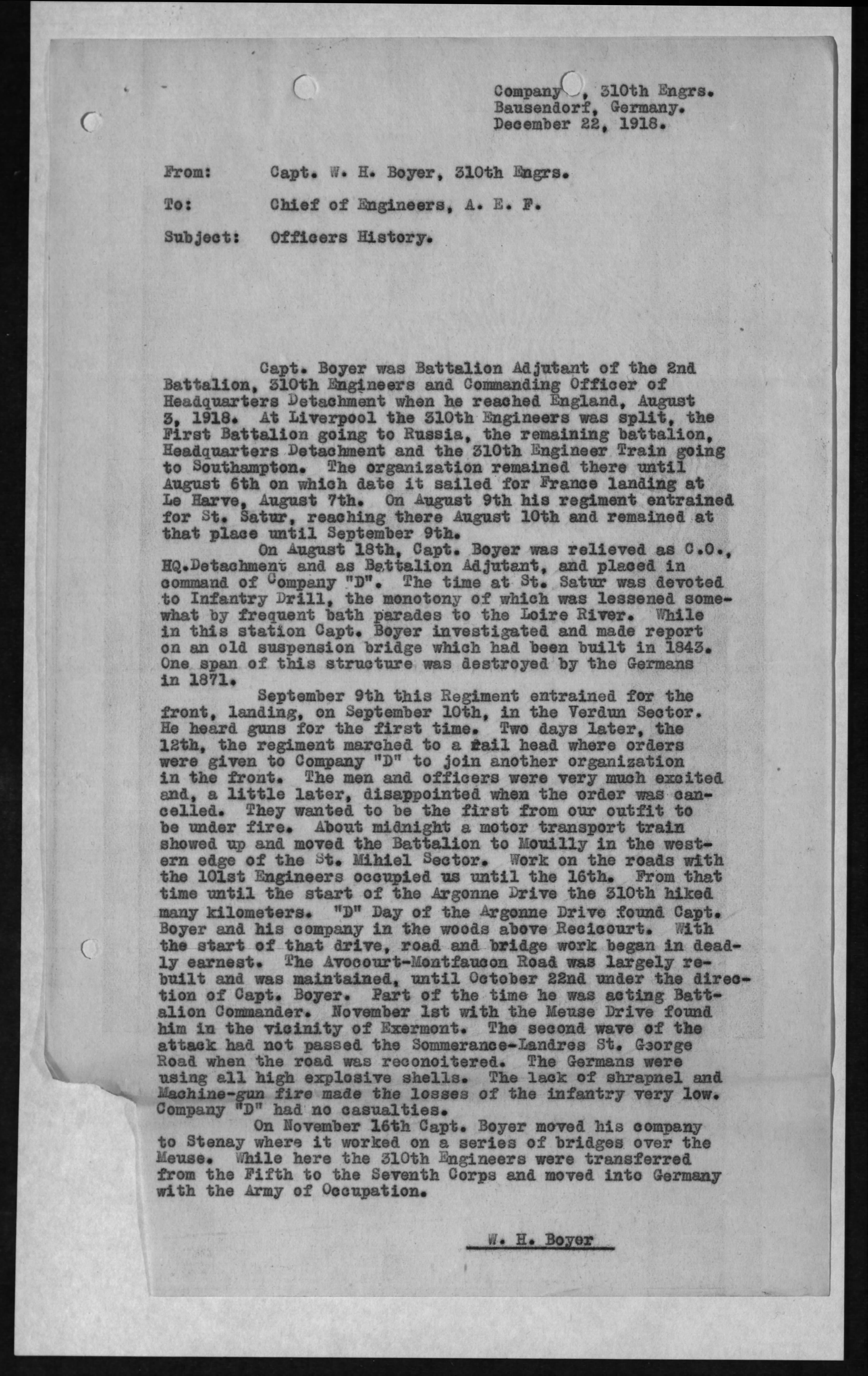
Capt. W. H. Boyer, December 22nd 1918
Major W. E. Dick, Headquarters



Major W. E. Dick, December 16th 1918
Lt. Col. David M. Duller, Headquarters 310-602













Lt. Col. David M. Duller, December 16th 1918
End
JON ENGELSMAN, FEBRUARY 13TH 2019, VERSION 0.3
- Posted on:
- February 12, 2019
- Length:
- 15 minute read, 3117 words
- See Also: